#even though it's probably more common as a verb than as a noun at this point
Explore tagged Tumblr posts
Text
i exist solely to test the expansiveness of accepted-word-databases in various word puzzle games. so far they have all failed to please me.
#the csw (sowpods) list is the least bad but they don't update it often enough#for example it recognises 'dogpile' as a noun but not a verb - and thus does not accept 'dogpiled' or 'dogpiling'#even though it's probably more common as a verb than as a noun at this point#it also has the usual blindspots for marginalised forms of english as well as some types of loanwords and jargon and internet neologisms#but it does better with those than most who attempt it
4 notes
·
View notes
Note
ive done a lot of translating to high valyrian in my day and id like to think im pretty good at it sometimes (the way ive spent literal hours researching how just one piece of grammar works to change a noun to an adverb or something is maybe insane)
anyway all that to say i usually know what to look for and how to apply it, but i am struggling with this new bit im trying to translate. “i disdain all glittering gold.”
ive replaced disdain with hate cause there doesnt seem to be a word for disdain in valyrian and hate is the closest approximation. same with glittering — replaced that with shine, and had to manually transform that to an adjective (jehikagon -> jehikere? dunno if its right)
so what i have now is “nyke buqan unir jehikere aeksion”
(im not as concerned with getting the word order right as i am with the rest of the grammar)
ive learned from a previous answer “nyke” is potentially (probably) unnecessary here, so that leaves it as “buqan unir jehikere aeksion,” but the unir there in the middle kinda makes it feel off and im not sure if maybe that also needs to be part of a compound word like valar or how to make it one if so because idk what part of valar is all and what part is men and how to fit aeksion into that equation.
i lost track of what my question was originally meant to be but i guess im wondering if im on the right track and if theres some guidance you may have to get me all the way there.
thank you for your time 🙏

Uhhhhhh... Not to be that dude, but...maybe be more concerned with that...?
I'm not sure if you know about this site, but my wiki is exhaustively updated with respect to High Valyrian, specifically. There's a team of people that work on High Valyrian and it's massive. For example, you could go to the entry for jehikagon and see that jehikere is wrong: it should be jehikare. And, of course, it has to agree with āeksion (note the long ā), so it should be jehikarior. To get the sense of repetitiveness (with "glittering"), you might add ā- to the front, so ājehikarior.
Now for "all", why not use the collective? This is how you get "All men must die", so it should work for "I distain all glittering gold". That would be āeksior. Of course, it would need to be in the accusative, so altogether it would be ājehikarior āeksȳndi. By adding the repetitive you kind of get the aliteration, too, since they both begin with ā.
Finally you have "disdain", for which buqagon serves. Aside from sound a little more posh, the difference between "disdain" and "hate" in English seems to be one of duration. The words "disdain" and "loathe" seem to emphasize that this is a character trait rather than a reaction. If you disdain something, you've given it some thought, have experience with it, and may use this as a way of describing or characterizing yourself. You can do this with "hate" as well, but it's a much more common word, and so can be used in other more basic ways, whereas "disdain" and "loathe" tend to only have specalized uses. To try to approximate this, you could use the frequentative with buqagon to imply a lengthy duration. That would give you jobuqan "I disdain". In fact, you could even use the aorist if you really wanted to imply that it was a description of yourself, i.e. jobuqin.
Now that you have the pieces, though, I really hate to say it, but the words must be in the right order. I mean, you can change the order of the noun and adjective, if you'd like, but you simply cannot put the verb first and think you've created a Valyrian sentence. It's not just "kind of" wrong: it's completely wrong. It'd be like suggesting "I him saw" is close enough in English because the forms are correct. It's not. It's wrong. This is not a minor part of the grammar you can ignore. High Valyrian is aggressively verb-final. The verb must be at the end.
All in all, that gives you:
Ājehikarior āeksȳndi jobuqin.
Hope that helps!
70 notes
·
View notes
Note
Are any of the other North Indian languages mutually intelligible with Hindi?
(other than Urdu)
Boy, did this ask take me down a rabbit hole. I have only studied Hindi and some Urdu, and my exposure to other Indian languages is mostly through fusion film songs that mix various languages. So if I make a mistake here, please feel free to expand and correct me!
India is home to a diverse range of languages, many of which share roots with Hindi in the Indo-Aryan language family. While some are highly mutually intelligible, others are more distinct but still share structural and lexical similarities.
When comparing languages with common roots, it's often helpful to look at the words that are probably the oldest, such as those for home, food, or basic verbs. Here's a comparison of Hindi and Urdu to six other Indian languages with three example sentences.
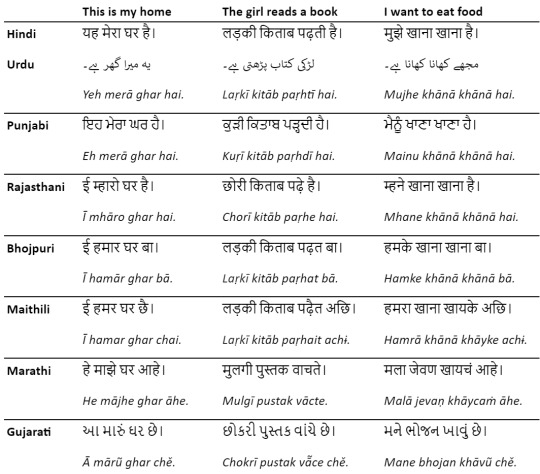
What we can see here:
Shared vocabulary: Words like घर, किताब and खाना are mostly consistent across the board and would likely be understood by many speakers of these languages. Words like पुस्तक, छोरी and भोजन are also familiar to Hindi speakers, though they might be considered more formal, regional or specific.
Grammar: all these languages follow the Subject-Object-Verb (SOV) sentence structure. Even if you encounter an unfamiliar word, this consistent syntax helps understanding and contextually deducing its meaning. Knowing where nouns, verbs and adverbs are likely placed in a sentence can be a huge advantage when learning or comparing these languages.
Script: Hindi uses Devanagari, Urdu uses Nastaliq or Naskh, Punjabi uses Gurmukhi in India and Shahmukhi (Perso-Arabian script similar to Urdu) in Pakistan. Gujarati has its own script, and others, like Maithili and Bhojpuri, also use Devanagari with minor regional tweaks.
So the answer to your question is: well yes, but actually no.
You can test how much you understand by listening to these songs! Some of them have a bit of Hindi influence or shared vocabulary mixed into them:
Punjabi
youtube
youtube
Rajasthani
youtube
youtube
Bhojpuri
youtube
Maithili
youtube
Marathi
youtube
youtube
Gujarati
youtube
20 notes
·
View notes
Text
Neat Irregularity In Old Sogoic Adjective Agreement
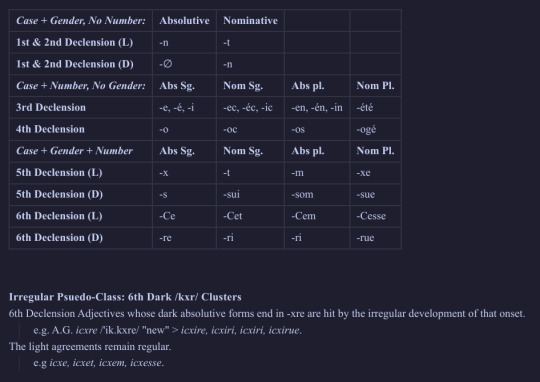
I think this is the first time I've mentioned it on this blog, but Old Sogoic is a Sellan language (i.e, fairly closely related to High Gavellian), though the Old Sogoic period (c. 850–500 B.P.) came a fair time before the Cadan standardization of High Gavellian that I'm documenting (early centuries A.P.) or even the point where "High Gavellian" became a distinct concept outside of Koine (riight before the turn of the millennium).
I digress. The irregularity here is a splinter from Declension VI detailed down below. As a result of a sound-shift vowel insertion to break up an unwanted sequence at the syllable boundary, the 'irregular' class takes the root (this is romanisation, not ipa, though it is phonologically transparent atm) icx- and simply adds an -ir for gender agreement and then -e/-i/-i/-ue for case and number agreement. It's so nicely agglutinative!
but this is the irregular pattern. compare a similar stem in declension six like sios-. In the light gendered agreement pattern, it matches icx- exactly:
icxe, icxet, icxem, icxesse
siose, sioset, siosem, siosesse
buuut ofc the "expected" dark agreement pattern...
siosire, siosiri, siosiri, siosirue
...is completely incorrect! because that final consonant is only a part of the light stem, for some reason! the dark stem deletes it!
siore, siori, siori, siorue
It's all so very nice. The vowel insertion during the sound shifts on the xre /.kxre/ clusters prevented the consonant loss that hit every single other adjective in the class. Maybe if there were more preservation examples than this one (rather rare) cluster then it'd have spread through analogy/morphological leveling or somesuch, but it hasn't. so it's just an irregular pseudo-class that only retains some super common adjectives (as detailed in the pic, icxe/icxre "new" makes that cut). The rest of them have this fun stem consonant deletion thing going on. Which also means that if you hear a Declension VI adjective in its dark agreement form you've got like zero clue as to what the consonant at the end of its stem is. rip rip.
Again, maybe I'll level that out, but realistically what I'm probably going to do is collapse the adjectives into 2-3 declension classes max. Probably going to move them up into 5-6 as the language gets more (yes yay more) fusional. Unfortunately we've got a billion incoming noun cases (lots of adpositions just went postpositional & suffix mode) that I don't really see the adjectives agreeing with, but at the least that's one place where the marked nominative agreement is going to hold on. Rest of the language (family) is doing its level best to purge itself of any remnant ergativity.
Here's a language intro tangent:
Old Sogoic is somewhat fusional, though sound shifts have rendered its inflection system fairly neutered and highly syncretic. It's undergoing the same areal morpho-phonological reduction pressure that the nigh-isolating High Gavellian emerged from. Given the circumstances it managing to hold on to this much (16 verb inflections, up to 4 noun inflections, up to 8 adjective inflections, grammatical gender & number) is insane.
The adjective classes are weird and I like them a fair amount. The first/second declension distinction is barely a formality and only exists because of One insanely productive derivational suffix (the gods' strongest soldier, good work -on).
It also exists because this analysis lets me line up the adjectival inflection patterns with their cognate noun declension patterns. If Declension II didn't exist then I'd probably have to skip the number anyway.
Otherwise the six declensions are sorted into three pattern groups depending on their agreement behavior. I and II are defective when it comes to number agreement, III & IV don't agree for gender, and then finally V & VI have full agreement in all situations.
Going off what I mentioned earlier but wrote later:
As Old Sogoic evolves into Neo-Sogoic (where its speakers escape the black hole of isolation by ironically isolating the community from the rest of the sprachbund) planning on having it get even more fusional, which means that I'm probably going to have V & VI style patterns of full agreement extend to the entire adjective space. Hooray. This'll mainly favor the absolutive forms, but I won't see if I can't force the case-like suffixes to agglutinate to the adjectives too. That'll get a whole bunch of new agreements in real quick.
4 notes
·
View notes
Text
A Guide to Language Domming, Pt. II
The Seven Key Phrases of Language Play
Welcome back! In Part I of this guide, I talked about what language play was, how you can engage in it with your little, and why it’s such a fun and immersive experience. I may also have mentioned that it’s possible to learn to language dom without being fluent in your target language beforehand. And in this part, I’m going to explain how.
Below are seven key phrases to keep in mind when you’re learning a language for play. With all of these, though, it’s not about translating the exact phrase - it’s about understanding the kinds of words highlighted, and being aware of them. These are language elements that common learning apps might not cover, and I’ll be including some helpful places you can look to fill in the gaps.
Beyond these, if you haven’t studied your target language much before, you probably will need to spend a week or two with DuoLingo, Youtube guides, and the like to get comfortable with language basics. Yes, it’s work, but isn’t it worth it to give your little one such a special experience? Plus, if you’ve ever wanted a good reason to go study a new language, it doesn’t get better or more fun than this!
Oh, and even if you have studied your target language quite a bit, or even if you consider yourself fluent, these might not be words or phrases you’ve thought much about, or are very familiar with. So read on, friend, and get ready to expand your vocabulary.
Phrase #1: “Good morning, Princess.”(Terms of endearment)
To be clear, “good morning” is fairly basic - Duolingo and the like will be sure to cover that in an early lesson. It’s the second part that’s trickier, and that’s because translating “princess,” or whatever word you like to use in English, isn’t going to cut it.
Common terms of endearment vary wildly from language to language. From the Spanish changuita (“little monkey”), to the Polish laleczko (“little doll”), every language has a wide assortment of colorful favorites. The lists are pretty easy to find online, and you’ll have plenty of great options no matter what you plan to study.
So why is it so important? Because for the duration of your play, this is essentially going to be your little’s name. Other than possibly the word “no” (if they’re an especially naughty little), your chosen term of endearment is going to be the word that they hear the most, and that they will have the strongest emotional association with when you’re done.
Phrase #2: “Now now, behave.”(Imperatives)
An imperative is essentially a command phrase - do this, don’t do that, and so on. In many languages, this is its own grammatical form, and learning imperatives means learning a few rules for verbs and their conjugations.
Now, all that sounds like it should be in a normal language syllabus, and it usually is. But I mention it here because this is one grammar lesson that you have to have to have down pat. Commands should be given clearly and quickly, especially if your little one has decided to be a bit of a brat. In fact, this is probably the most common way you’re going to be using verbs in play - you can’t really have much of a conversation, after all.
Some of the variations aren’t obvious - even with something as simple as “no!” it’s worth noting that some languages prefer “can not!” and some just say “bad!” So be sure to spend a little extra time on these lessons, so you can be ready to give some lessons of your own.
One last note on this: imperatives are probably the single most important part of language domming if you’re using it in a petplay context, and “training” your pet to follow commands in your target tongue. Now, that’s not something I’m personally experienced with, but boy does it sound like fun!
Phrase #3: “Would you like your teddy bear in the playpen?”(Household items)
As with imperatives above, common nouns for household items are already a part of the normal language lessons you’re likely to find. The tricky part here is that everyone’s household is different, especially when we throw in a whole bunch of paraphernalia. You might have your Italian words for sofa (“divano”) and refrigerator (“frigofieri”) down pat, but how about teddy bear (“orsacchiotto”)? How about baby bottle (“biberon”)? And did you know that the term used for playpen is just box? I sure didn’t, before I made this guide.
Obviously, not all of these are going to be featured in your standard beginners’ lessons, and Google is your friend. If you do use the translation tool though, be sure to swap back and worth to make sure it’s got the right word (if you put in “seal” because your little one has a cute baby seal, you may end up with the word for stamp, etc.). Also be sure to press that sound button to actually hear the word - some of them aren’t what they look like, and accent is important for the immersive experience!
Phrase #4: “Uh oh, did somebody make a pee-pee?”(Potty euphemisms)
Okay, you probably saw this one coming. It’s for those moments that so many AB/DLs and their caregivers look forward to - when we discover that our little has had a little accident. Language domming is all about creating a deeply immersive experience, after all, and what could be more immersive than being talked down to for using your diaper, in a language you don’t understand, knowing full well you’re about to be laid down on the mat and changed, and that you’re too little - and know too few words - to have any say about the matter? Sounds fun, right?
For those unfamiliar with the term, a euphemism is a ‘nice’ way of putting something that might not be so nice to talk about. With ‘potty’ related words, these are important, since technical terms for urination, defecation, and even diapers can be clunky and awkward. Knowing the right words to use for pee, poo (if you want to include that), potty, diaper, change, accident, and so on can go a long way.
Of all of the words covered on this list, these might be the trickiest to actually look up, but you can find some useful discussions in forums online. Here’s a lovely Wikihow guide on talking about poop in Spanish, and here’s a Reddit thread covering “polite ways to talk about bodily functions in German.”
Now, in the future, I’d love to start a repository of these lovely terms for ageplayers around the world to fill in, but that’s going to require you sharing this out with all your kinky friends! But I digress.
Phrase #5: “Ummmm… uh…”(Filler words)
Huh? Yes, believe it or not, knowing how speakers of your target language handle those awkward pauses we all have is important. The “ehhhh”s and “ahhh”s of the world are different, and you’ll want to get used to your target’s.
Why does it matter? Because accent is important. You want to create an immersive experience for your little, and sounding like a high schooler trying to fill a foreign language credit is not the way to do that. Having a confident accent (doesn’t mean it’s great - you won’t be tested on that) is crucial, and being able to maintain that when you’re looking for the words to say is a big deal.
One of the best ways to pick up on these filler words and how they’re said in your target language is to watch candid videos. Reality clips, interviews, man-on-the-street type deals - all of them will have people looking for what to say, and you’ll be able to see what they look like when they do.
Phrase #6: “Awwww, does my widdle pwincess want her stuffy-wuffy?”
(Diminutives)
If you’re wondering how to really baby-talk your little in your target language, the key is here, and it might be a bit more technical than you think. Baby-talking in language play, as it turns out, comes down to a combination of confident accent, CG attitude, familiar terms of endearment, and a whole bunch of diminutives. I’ve covered all of those things except the last - and it’s a big one.
Technically speaking, a diminutive is a modification of a word, used to convey smallness, endearment, or both. Tommy is a diminutive form of Tom, doggie is a diminutive from dog, and so on. When encountering foreign examples, they usually end up getting translated as ‘little’ + whatever the original root word was.
For many foreign languages, there are actually pretty clear rules about how to create a diminutive, and a lot of them have to do with endings added on, such as the Portuguese -inho / -inha, or the Czech -ka and -ička/-ečka. Wikipedia has a colossal list here, though you may need to have some knowledge of your target language’s noun cases and word structures to process it.
If all that sounds complicated, well, it can be at first. But once you nail that condescending tone and make your little just burn up blushing, it’s all going to worth it.
Phrase #7: “Oh, goodness, did I forget to turn off the thingamajig?”(Placeholders)
Last but not least on the list are those words that we use when we know exactly what we're talking about, but we don't know how to say it. And while catchalls like the English thingamajig, whatchamacallit, and doohickey do exist in other languages (including, amusingly, the Spanish chimichanga), this topic is much bigger than that.
The key point here is that you don't want to interrupt the immersive experience you've worked so hard to create, just because you happened to forget the word for toaster or the like. You can use the word for thingamajig. You can use the word for that. Or - and this can be our little secret - you can even make something up!
Remember, this isn’t a test. You’re not being asked to master a foreign language. Just to use what you know - maybe you’re doing a Duolingo crash course from scratch, maybe you took it in high school or college, maybe you know some from family - to make for the best, most immersive play experience you can give your little one. And hopefully, these phrases can help with that.
Phew. Hope you all learned a bit today! If you have any questions, or any suggestions for what I can add above, feel free to shoot me a DM. And if you want to help me build my repository of foreign language vocab for AB/DLs, please do reach out!
In the next and final part of the trilogy, I’ll be going over some slightly more advanced tips and tricks for language players, including a deeper dive into activities and props for play, combining language domming with other kinks, and even my picks on which languages most and least lend themselves to all this fun wackiness. As always, my friends, keep it kinky. - ONND
Pt. III Can Be Found Here
71 notes
·
View notes
Note
Hey Profe 🍓:
Can you guide me through esdrújulas and how commands become them? They require the tílde, right?
When words are esdrújula, yes they require the tilde... not all commands are esdrújula but we'll get into it this is going to be a long one; but just know, it's not something you fully get at first, it's a pattern you recognize and keep recognizing as you go
I just want to quickly state that the entire topic is related to whether words are aguda, grave/llana, or esdrújula which is a very large topic that is a bit confusing - but it basically describes where you put your vocal emphasis on a word depending on if it ends in a noun, a consonant, N or S...
Again, not something you "learn" exactly but a pattern you realize you've been recognizing and how you know how to pronounce a word based on a pattern you've probably noticed without even trying, but then trying to understand it academically which is the weird part
Very big topic linguistically; I recommend looking it up on youtube but it's related to how to predict where to put a vocal emphasis on a word and if it should have an accent mark depending on syllables and what the word ends with
-
For your purpose though you're talking about esdrújula which means that a word has its vocal emphasis on the third to last syllable [antepenultimate]
A common example is la brújula which is a "compass"
The syllables in that are brú-ju-la
...That la is the last [ultimate] syllable, the ju is the second to last [penultimate], and brú is the third to last [antepenultimate]
Without an accent mark you would be inclined to put the emphasis on ju but because its emphasis is on brú it gets the accent mark to tell people that so they don't pronounce it wrong
-
With verb conjugations you're looking at more of a.... I don't know what the right word for it is but let's just say "imposed esdrújula"
By that I mean you're adding syllables to a word and that will change how it's pronounced
This is the basis being un making algún, ningún, or a counting word like veintiún "21 (of something)" have accent marks
By adding extra syllables you moved where the vocal emphasis would typically be. To make sure you understand we're talking about a root of un "one", that now takes an accent mark because if you didn't people would be pronouncing it wrong
[I said I wouldn't really go into it but most nouns ending in N have their vocal stresses on the second to last syllable like dicen, tienen, viven, hablan etc. because you want people to recognize un is from uno and related to "one" you're putting emphasis on that syllable which is unusual - hence an accent mark to keep people from messing it up]
This is the same idea behind seis as 6 turning to dieciséis 16 because people want you to know that it's related to the number 6, but most words ending in S have their vocal stress on the second to last syllable like tienes, caramelos, dulces, manzanas
Words like el compás "rhythm", además "furthermore" have the same vocal stress on the last syllable and end in S so they need the accent mark to not confuse people
-
Verbs also do this with commands, as well as some that use the infinitives or gerund forms + indirect objects, direct objects, and reflexive pronouns
With a verb in a command + objects, you're also adding syllables while also trying to keep the vocal stress originally where it was:
Habla. = Speak. Háblame. = Speak to me.
You turn a two syllable word into a three syllable word; but by keeping the stress on the same syllable you then need to add that accent mark to make sure people don't emphasize "bla"
This is the same for hábleme, or háblenme for usted and plural commands rather than simple hable, hablen.
...
This is somewhat different for a monosyllabic verb [often dar] or a verb with an irregular monosyllabic conjugation:
Da. = Give. Dame. = Give me. Dámelo. = Give it to me.
esdrújula by its nature needs at least three syllables, so immediately dame as a command only has two and works like normal so no accent mark, suddenly by adding a third syllable but still saying da has the stress means you need the accent mark
A somewhat unique thing then happens in usted it's that as an usted command it's dé "give", to differentiate it from de "of" it has that mark. But deme has no accent mark because it looks like a normal word with no accent mark needed - again better explained in a discussion of words that are either aguda or grave/llana - but then démelo "give it to me"
Another common one is poner to pon as a command but with reflexives and a direct object:
Pon. = Put. Ponte la ropa. = Put on your clothes. Póntela. = Put them on. [la ropa, collective noun] Ponte el vestido. = Put on the dress. Póntelo. = Put it on. Ponte los guantes. = Put on the gloves. Póntelos. = Put them on. Ponte las botas. = Put the boots on. Póntelas. = Put them on.
...Again compared to ponga in usted which already has two syllables, póngase "put on" or póngaselo-la-los-las can work like that too
This is also going to be why you see some verbs that have roots with poner, tener, venir etc conjugate a bit weird... like mantén is because ten is the command of tener for tú, now you have another syllable as mantén from mantener and it's a whole thing
...
Now I mentioned infinitives and gerund, and again this is easier to spot but it has to do with syllables again
Infinitives all have their tonic stress on the last syllable, so when you add things you're moving back that syllable from ultimate to penultimate to antepenultimate...
Necesito decir... = I need to say... Necesito decirte... = I need to tell you... Necesito decírtelo. = I need to tell it to you. / I need to tell you. Debo dar... = I should give... Debo darte... = I should give you... Debo dártelo. = I should give it to you.
This is why you might see something like ahora tendrás que vértelas conmigo as it's "you'll have to deal with me" but literally verse las caras "to deal with" kind of like "to see face face to face", so it became "see them with me" in a way as vértelas
Another common one is apañarse las coas "to handle things", and then sometimes as a command apáñatelas "deal with it / figure it out" or necesito apañármelas "I need to deal with it (myself)"
With gerund you're talking -ando or -iendo or -yendo. They're already multiple syllables so they always have an accent mark [on the -ándo, -iéndo, -yéndo] if you add to that word with a direct object, indirect object, and/or relflexive:
Me estás mintiendo. = You're lying to me. Estás mintiéndome. = You're lying to me. Se está volviendo loco/a. = They're going crazy. Está volviéndose loco/a. = They're going crazy. Les estoy diciendo la verdad. = I'm telling them [or "you all"] the truth. Estoy diciéndoles la verdad. = I'm telling them / you the truth.
-
What (thankfully?) makes this easier is that you can hear it and produce it pretty intuitively
It's just that the accent marks with esdrújula and especially with verbs is there so other people don't read the words wrong
It becomes a confusing topic because it's describing a thing a lot of people do naturally, but you can tell when someone gets the emphasis on the wrong syllable because it will sound off
16 notes
·
View notes
Text
Daily French words!
Intro:
Hi! I'm a French college student, and I study English literature and civilisation. I'm starting this page because I have a shit ton of extra French vocabulary to learn for exams, and it's a lot more fun to learn them through a tumblr page rather than just reading a piece of paper for hours!!!! All credits for the ideas for the first 160 main posts of this page goes to both of my French teachers this year, they're the ones who gathered up the lists- I obviously can't name them because I'd rather not dox myself (or them), but thanks!
Form :
(French word) : (French definition)
(example of the word's use in a French sentence)
(how common the word is out of ten, 1 being so uncommon people will look at you weird if you use it and 10 being common knowledge people will go "duh" at. please note this section will be the most subjective of the bunch and is purely based off my impression- the factors, such as social circle, time and place make it too difficult to have a more objective knowledge of how common said word is.)
(a possible translation in English) : (a definition in English because I like definitions)
(extra notes and precisions for context use, potential irregularities if it's a verb, other possible definitions, similarities, faux amis (see frequently used terms lower) or etymology because I'm a nerd)
Schedule :
Each week, ten words will come out : one each Monday, Tuesday, Thursday and Friday, and two each Wednesday, Saturday, and Sunday!
Posts will be uploaded around midday CEST, so between 11am and 2pm, depending how I schedule them/at what time I eat.
Extra requested words can be uploaded anytime from 6am CEST to 2am CEST (the next day).
Every main daily post will be gathered under the "main" tag, extras will be gathered under the "extras" tag, and other random posts I may feel free to upload about the most random college life shit ever (even if probably really rare) will be gathered under the "baguette" tag.
Things to note :
These words are not common! This is vocab improvement. If you're looking for basic knowledge of French vocab or common phrases, you may have to look elsewhere.
I sadly only speak two languages, English and French, so this blog is only accessible to people speaking one or both of these. If you'd like to translate it to other languages (especially since the additional notes are all in English, and a lot of notes and translations vary), feel free to do so but please DM me about it before starting the blog, and of course credit me!
If you'd like to request a word, do so through the page's asks! That's mostly useful if you'd like extra context on the word, its etymology or its history, or if you feel like it could be a cool word to be featured on this page. Of course, these extra words may take time to appear and will be scattered quite a lot through time since they require extra time and research, and I may refuse some of them if I don't think they'd be a good fit on here. Requests made through DMs will not be taken into account. Please only make requests through the ask feature, and wait until the asks open again if they're closed while I sort through them.
At the moment, I have 160 words, so enough content for four months (see schedule above to see how I count them). I cannot guarantee this page will update with the same schedule or update at all once I run out, depending on whether I still like doing it by then or prefer to stop. If it does stop updating though, I will leave all the posts up because knowledge is knowledge, and I may pick it up once in a while if I ever get bored and want to have fun with it again or if the asks supply me enough to sustain the page.
Frequently used terms (that you probably know already but I want to make sure everything is clear):
n. : nom/noun
nf. : nom féminin/feminine noun
nm. : nom masculin/masculine noun
nn. : nom neutre/neutral noun (we probably won't encounter any, but just in case, I'm putting this here!)
v. : verbe/verb
adj. : adjectif/adjective
sy. : synonyme/synonym
ant. : antonyme/antonym
litt./lit. : littéralement/literally
faux ami : expression that refers to a word that resembles another one in the same or a different language but that differs largely in sense.
About sources:
For most definitions and translations, I use the online Larousse dictionary (https://www.larousse.fr/dictionnaires/francais/), the Wikitionnaire (https://fr.wiktionary.org/wiki/) and WordReference (https://www.wordreference.com/).
For etymology and word history, I use a mix between the Wikitionnaire and the Centre National de Ressources Textuelles et Lexicale (CNRTL)'s website (https://www.cnrtl.fr), along with paper versions of etymology dictionaries.
#how do you tag#uh#intro post#french#words#i guess#french words#vocabulary#french vocabulary#college things#educational purposes#kinda#serious stuff#that is probably gonna be littered with dumb shit#wish me luck#exams#kind of i guess idk#i've been on this site for months and still cant tag#help#does this fall under the#main#tag or the#baguette#tag?#who knows#not me#okay i think that's enough tags#can't wait to do this!!! it's gonna be so much fun!!!!!!#i love languages#languages
4 notes
·
View notes
Text
Frislandic Historical Phonology
Ok so what the hell is with this phonology? Why this three-way aspiration contrast? What's with those aspirated labials? Those mutations? And why so many goddamn diphthongs?
All these questions and more will not really be answered but there'll at least be some more relevant information.
So Proto-Frislandic is a very nebulous entity, because many of the details of reconstruction are still hotly contested, some of which we'll discuss in a moment. For now the general consensus is on a reconstructed inventory like so:
*p *t *c *k
*pʰ *tʰ *cʰ *kʰ
(*s) *ʃ
*m *n
*r *l
*i *e *a *o *u
Roots had a C(n, l, r)V(ː)(n)CV structure with nouns and a C(n, l, r)V(ː)C- structure with verbs. *r did not occur root-initially, and do not seem to have been particularly common root-medially either. The exact quality of *l is also of some debate: some authors suggest it was likely some kind of lateral fricative (which is its primary reflex root-initially), rather than an approximant, but a resolution on this issue is likely impossible. *ʃ is also of uncertain quality, but it was likely retracted and slightly retroflxed, not palatal.
Authors tend to disagree most on the palatalised series, as there were probably three different sources for this in Pre-Proto-Frislandic: underived, palatalised dentals and palatalised velars.
The palatalisation of dentals before *i was most consistent (even today dentals never occur before reflexes of *i in native roots and there are scarce occurences even in loans; see e.g. zivl 'devil' and kerz 'believe' from Irish diabhal and creid respectively) and was a semi-productive part of derivation even in Proto-Frislandic, particularly for deriving basic agent nouns from verb roots. However it should be noted that paltalised *tʰ gave (not yet contrastive) *s not *cʰ (which in most varieties later merged with *ʃ to give modern /s/) so e.g. *kʰlat- 'return' → *kʰlaci 'returnee', *trotʰ- 'follow' → *trosi 'follower'. In modern Frislandic these are kald → kælz and dost → dors respectively, though note the nouns are lexicalised as 're-immigré, returning expat' and 'disciple' respectively. Some authors propose a distinct *t͡s from palatalised *t on the basis of some dialectal reflexes.
There's also evidence of palatalisation of velars, but this is less consistent outside of again agent noun forms (e.g. *ʃuk- 'speak a language' → *ʃuci 'speaker', *ʃrikʰ- 'sweep, brush' → *ʃricʰi 'sweeper'; modern sug → suz 'interpreter', sjisk → sjisj 'brush'). Some authors propose an additional series of indeterminate quality (some say labio-velar, some uvular) to explain forms such as *kriːta 'gland', modern girið, *kʰiːta 'sheath', modern kijð 'vagina'.
And there are still a number of palatals which cannot be explained through any kind of palatalisation process, such as *tʰoc- 'come', *coːta 'body', *cʰoːnti 'urine', modern toz, zuoð, sjuojn.
Additionally, while *tʰ *kʰ are still aspirates in most varieties to the present day, *pʰ *cʰ were likely already fricatives *ɸ *ç at the Proto-Frislandic stage. This shift was likely an early motivator for the breakdown of the aspiration dissimilation Grassman's Law-style which was present in pre-Proto-Frislandic and still is the general trend for native vocabulary and the formation of inanimate plurals (even seeing extension to loanword, e.g. gekirk /kəˈkʰirkʰ/ 'churches'), but is otherwise no longer productive (see previous example).
When it comes to the vowels, since unstressed root-final vowels were later lost, the contrasts in root-final vowels can be difficult to reconstruct outside of the context just outlined. The main contrast that can be adduced is between high *i *u and low *a *e *o, as these exhibit differing morphophonological behaviour, as well as being the motivation for the allomorphy of the modern Frislandic animate plural -u~o and genitive -i~e.
Already in Proto-Frislandic, the high vowels *i *u underwent syncope in certain morphololgical contexts, most notably in compounds, but traces of syncope in other contexts can be seen elsewhere (e.g. the instrument noun suffix -ll from *-li-tV). As such, there is a split between compounds where the first root ended in a high vowel and thus exhibited syncope and those where it ended in a low vowel and did not. In the former case stress was placed on the first syllable, the second later ended up undergoing vowel reduction and the consonant cluster was simplified, sometimes in rather radical ways (the full set of which will have to wait till another time), for example:
*citʰu + *paːʃa → *tiʰpːaːʃa to zitt 'jaw, chin' + bar 'stone' → zippar 'teeth'
*pʰonci + *pʰraːci → *pʰoɲpːʰraːci to onz 'sheep' + æræj 'bearer' → ojmpræj 'shepherd'
*traːkʰu + tʰaːci → *traʰtːaːci to darak 'length' + tæj 'dog' → dæstæj 'weasel'
*kʰoːku + *tuʃu → *kʰotːuʃu to kuo 'swamp' + dus 'berries' → koder 'cranberries'
*iːsi + *kʰreta → *iʰkːreta to ijr 'seaweed' + kærd 'bread' → ikkreð 'laverbread'
*tʰolu + *ʃeːli → *tʰolːeːli to toll 'shell' + siel 'slug' → tollel 'snail'
Note also that verb-noun compaunds exhibit the same behaviour.
*poːt-pʰaːli → *popːʰaːli to buoð bind' + æl town' → bopæl 'league'
*sinc-kʰuːnu → *siɲkːʰuːnu to sinz 'soak' + kwn 'bone' → sinkun 'bone broth'
*pent-tʰaːci → *pentːʰaːci to bænd 'guard' + tæj 'dog' → bentæj 'guard dog'
On the other hand, where the compound ended with a low vowel, syncope did not occur, stress was on the third vowel (the root vowel of the head of the compound) and the only substantial change was and is still lenition. This kind of compounding remains at least somewhat productive into Modern Frislandic, even with forms that would historically have behaved like high-vowel roots.
*maːte + *pala → *maːtepala to mæð 'pine tree' + ball 'seeds' → mæðvall 'pinenuts'
*mukʰa + *tuːkʰa → *mukʰatuːkʰa to mukk 'pigs' + dwk 'shark' → mukkðwk 'angel shark'
gat 'street' + tren 'train' → gættren 'tram'
sjuj 'tally, record' + kist 'box' → sjujkist 'computer'
So how did we get to modern Frislandic? Well I'm not going to go into all of the details but there's a few key points to make.
Firstly, vowel length an consonant length got slightly re-jiggled. Basically, single consonants after stressed short vowels became geminated (this was probably also when long vowels after geminates from cluster resolution shortened). Remaining single plain consonants would voice and then lenite intervocalically, while geminated forms of the aspirated stops *tʰ and *kʰ would be pre-aspirated, the singleton versions remaining post-aspirated. Note that this does not include the already post-aspirated geminates from cluster resolution seen above. The long vowels did remain different in quantity, as there were subsequent shifts in quality, including breaking (producing the first set of diphthongs ie uo ij w /iə̯ uə̯ əi̯ əu̯/). Furthermore the long vowels retained their quality when unstressed while the short ones were reduced. Thus:
*ʃuci → *ʃucːɨ → suz /syt͡s/
*citʰu → *ciʰtːɨ → zitt /t͡siʰt/
*kʰreta → *kʰrætːə → kærd /kʰært/
*kʰoːku → *kʰoːgɨ → kuo /kʰuə̯/
*kʰotːuʃu → *kʰotːɨʒɨ → koder /ˈkʰutər/
*maːtepala → *mæːdəbalːə → mæðvall /mæðˈβɑɬ/
Some other major changes to note. Firstly, the aspirated *pʰ and *cʰ behave differently. *pʰ (when not already geminated because of a former cluster) lenited to *ɸ and was sunsequently lost regardless of length and position (hence the discrepancy between the exonym Fri[sland] *ɸriːka~*ɸriːkaʃi-kʰuta and the modern reflexes Iri~Irijkud /ˈiri/~/ˌirəi̯ˈkʰyt/). Similarly, as *cʰ was likely lenited to *ç early on it participated in lenition in the same manner as the plain obstruents, resulting in its alternation being voiced-based rather than aspiration based.
A second change to the vowels not yet mentioned has to do with umlaut. The default reflex of Proto-Frislandic *e in modern Frislandic is /æ/. However, there was a process fo umlaut before original from vowels *i *e in a following syllable which resulted in its retention as a mid-front /e/. In this same environment original *a was fronted to /æ/ as well. The distance this umlaut effect can travel seems to have varied across Frisland: in some regions (in particular the capital Ojbar where the standard derives from) it only seems to have travelled one syllable, suggesting that in these cases it probably arose as a result of co-articulation effects on consonants, though there was seemingly a subsequent process of /æ/-dissimilation which produced forms such as bentæj /ˈpentʰæi̯/ 'guard-dog' (as opposed to *bæntæj). In other areas this instead seems to have been more like true umlaut, and these regions also tend to have expanded vowel systems due to the application of umlaut to the back-rounded vowels (but that's a story for another time).
Finally, those word-initial clusters underwent metathesis relatively late, with complete metathesis with short vowels and a kind of 'liquid-interpolating' with long vowels (see e.g .'weasel' above). some more educated speakers do pronounce such initial clusters in loanwords, but not always. Furthermore, this change only occurred word-initially, so there are still a lot of alternations of the kind gald~gelad /kɑlt/~/kəˈlɑt/ 'battle(s)', soroð~seruoð /ˈsuruð/~/səˈruə̯ð/ 'spear(s)' and bænll~bonæll /pænɬ/~/puˈnæɬ/ 'walking stick(s). This has even undergone extension to loanwords in some cases, such as koron~gekruon /ˈkʰurun/~/kəˈkʰruə̯n/ 'crown(s)' or sjuru~sjirw /ˈɕyry/~/ɕiˈrəu̯/ 'screw(s)'.
So yeah a bit long, hopefully I'll actually get onto dialectology next time.
8 notes
·
View notes
Text
Ghilan'naelvish II
(This took me much longer than expected, sorry guys)
Once Rook & friends hack Razikale down to a sliver of health, Ghilan’nain snarls, “They take too much,” and commands her to return. Razikale is melted down, reformed, then returned to the moat, emerging as the Eborsisk from [ the 1988 movie, “Willow”. ]
Again, Ghilan’nain has two lines here:

"Essana ellath vallan."
(Spoken as Razikale’s previous form is manipulated into something else)
This one took me forever, not only because the phonemes are so common but also because of how little sense it makes. This line reads more like ‘words’ than ’dialogue’. Eventually I realised that may actually be the point: it's an incantation.
Essana = change/reform
This one I'm pretty confident of. I found multiple, completely different, ways of translating it that all break down to some variation of “become something else”.
e (v. inf. be) + sa (another, again) + nas (soul, self ; from) literally: from (you/yourself) become again
Ellath = Requirement ; force
This sounds like it’s being pronounced with a soft 's' (/s/ = simple, sun) rather than the ‘th’ (/θ/ = thing, thought) that’s shown. That might make more sense, as 'lath' is almost always used for love, lovers, and intimacy. I did find a (canonical, if archaic) reference of 'lath' as “need”, not necessarily romantic or sexual, and if that’s the case, ‘El’ could be the article or superlative rather than a possessive "our".
90% of my time was swapping out various interpretations of this word. Here's a few:
El + lath = The need (as in, ‘there is need for’) ; our needs ; requirement El + ath = piece, small amount (superlative + divide, part, fraction) El + lath = the love ; our love ; obsession ; devotion El + las = force (superlative + give, grant) ; bestow ; gift Elas = can/may, conjugated E + las = become hope ; memory ; ambition e + la + ath = being / become (v. to be + intensifier + noun from verb action - though this is kind of like making a word out of “ing”, “epic” and “ish”).

I trust you see the issue.
In context, “need/requirement” makes the most sense, but doesn't scan as well. As an incantation, the words stand on their own as commands.
Vallan = summon / invite
vall (v. bid/invite/order/summon) + an (suff. location/place) ; an (posessive) vall (same, but conjugated)
Without the ’s’ this is probably val/valla, as it was used by the guardian spirits in Trespasser. If the Inquisitor knows the passphrase, they stand down and invite you through with, “vallem (vall + em “[I] welcome/invite/bid”) as part of the phrase, "atish'all vallem". Somehow I can't imagine Ghilan'nain politely asking Raz to go stand on their marker, pretty please with a cherry on top, but if paired with ellath, it may tie together as "demand" or "order".
I can't say with 100% confidence what each word in this line means -- the context is doing most of the heavy lifting -- but there's enough to get what it's trying to say conceptually.
~ "Reconstruction is necessary, heed my order"

“Vallasan inall lasa!“
(Spoken authoritatively as Razikale reappears on the battlefield)
Vallasan = place of life ; body
vallas (life) + an (location suffix; possessive suffix)
Vallas as a root word has multiple meanings. We’ve even seen “vallasan” in canon — it’s the name of a unique bow in Jaws of Hakkon — though we have to infer its meaning. What’s weird about Ghilan’nain’s use of it here is that's [ very clearly not what she's saying ]. Whatever word she's using has two syllables; the "lla” has been dropped. That said, I think this is a line read error rather than a captioning error -- the translation makes more sense as shown.
Inall = dwellers / lives
ina (v. to live, to dwell - conjugated) ; + al (may indicate collective grouping)
Lasa = grant/allow/give
= "Bring me the bodies (of the living)"
Ghilan’nain’s Elvish
People seemed to enjoy the psychic bitchfight post so I figured I’d do one for Ghilan’nain’s lines in the ‘Siege of Weisshaupt’, too. Once again, I'm no expert, all glory goes to to [ FenXshiral ], and remember this is a vibe-based language so results vary with context, inflection, speaker and so on.
In the lead-up to the boss battle, First Warden Jowin will show up to take Davrin’s place as final sacrifice, only to be snatched up by Ghilan’nain before he can deliver the blow. After remarking on the quality of his blood, Ghil rips out his heart, turns it into an archdemon strength buff, then drops the used-up Warden like hot garbage. A moment later Wyrm!Razikale emerges from the moat to start the fight.
Ghilan’nain has two lines in this cutscene:

“Lasa hedallin ghellara”
(Spoken either to or about the First Warden as she manipulates his blood/heart).
Lasa = grant/allow/give
hedallin = blood of a noble kill/sacrifice; blood of [your] defeat
1. hel/hell (adj. noble, moral, just) + dala (v. kill, destroy) + lin (n. blood, person m.)
or 2. [hela (v. contest, oppose, fight) + dala (v. kill, destroy)] + lin (n. blood, person m.)
The use of ‘noble kill’/‘blood of your defeat’/‘sacrificial blood’ feels very deliberate here. Just before Ghilan’nain grabs him, Jowin recites the Grey Warden motto, “In war, victory! In peace, vigilance! In death, sacrifice!” . She’s throwing his words back at him, saying his ‘sacrifice’ would’ve been a waste... she'll put it to better use. She even taunts Rook with this later in the fight: “Witness! A Warden’s blood to birth your own destruction.”
ghellara = [my] beast more strong
ghe (n. monster, beast, creature) + elvara (v. to make difficult, hardy, sturdy, complex; from adj. elvar) + el (more, much, many. Used as a superlative) + ara (pron. sb. poss. my)
= “The blood from your sacrifice will strengthen my beast.”

"fenathra mellas”
(Spoken as Razikale’s transformation completes)
The natural assumption is fen = wolf, which would result in: fen (wolf) + ath (embodiment of) + ra (prn. it) or ara (my, possessive), making it, ‘the wolf’ in a kinda roundabout way. More like, “that wolf guy” or even, "my wolf guy" instead of a name or title. But I don’t think Ghilan’nain is invoking Solas or "the wolf” here. He isn’t an opponent at this point in the game, and neither her nor Elgar’nan see him as a real threat anyway. Additionally, the way she says the word ‘fenathra’ is quite soft — almost wistful — especially by comparison to the deep, guttural, delivery of, “mellas”. I think the root word she’s using here is actually ‘fenor’.
She calls Razikale her greatest creation. She mourns her death; pitifully telling Elgar’nan that Rook took her away. Razikale is more than just important to her — she is the very embodiment of the word 'precious'.
fenathra = My Precious One
fenor (precious) + athe (used to change the meaning of an existing word into, ‘physical manifestation of’, or ‘embodiment of’, eg. “the dead��� from death) + ara (my)
Mellas = Allow now / Go!
melana (adv. now, in relation to ‘time’ or ‘when’) + lasa (v. grant, allow, give, let - imperative verb form)
= “Go, My Precious One!”
I've been working on her remaining lines for several days now and am currently tearing my hair out about it, but I will add them to this post as a reblog once I finish!
As a bonus I'll throw in Solas' dialogue to Davrin when he briefly joins your party at the end of the game.







Dialogue source: Solas Interaction with All Companions [ x ]
"Mala shivanas ar athim"
mala (your) shivana (to do one’s duty, conjugated) ar (I) athim (humble, humility)
The Elvish scans in Solas’ Hallelujah cadence, so I preserved it for the translation.
= “I am humbled by your duty," or, "Your sense of duty humbles me"
#dragon age: the veilguard#dragon age: veilguard#DA:TV#DA:V#elvhen cipher#elvhen translation#ghilan'nain#DA elvish
169 notes
·
View notes
Note
Hey! I hope you feel better soon
We haven't had a good long linguistics rant from you in a while!! How about you tell us about your favourite lingustical feature or occurrence in a language? Something like a weird grammatical feature or how a language changed
If this doesn't trigger any rant you have stored feel free to educate on any topic you can spontaneously think of, I'd love to hear it :D
ALRIGHT KARO, let's go!! This is a continuation of the other ask I answered recently, and is the second part in a series about linguistic complexity. I suggest you check that one out first for this to properly make sense! (I don't know how to link but uh. it's the post behind this on my blog)
Summary of previous points: the complexity of a language has nothing to do with the 'complexity' of the people that speak it; complexity is really bloody hard to measure; some linguists in an attempt to be not racist argue that 'all languages are equally complex', but this doesn't really seem to be the case, and also still equates cognitive ability with complexity of language which is just...not how things work; arguing languages have different amounts of complexity has literally nothing to do with the cognitive abilities of those who speak it.
Ok. Chinese.
Normally when we look at complexity we like to look at things like number of verb classes, noun classes, and so on. But Chinese doesn't really do any of this.
So what do Chinese and languages like Chinese do that is so challenging to the equicomplexity hypothesis, the idea that all languages are equally complex? I’ll start by talking about some of the common properties of isolating languages - and these properties are often actually used as examples of why these languages are as complex, just in different ways. Oh Melissa, I hear you ask in wide-eyed admiration/curiousity. What are they? By isolating languages, I mean languages that tend to have monosyllabic words, little to no conjugation, particles instead of verb or noun endings, and so on: so languages like Vietnamese, Chinese, Thai and many others in East and South East Asia.
Here’s a list of funky things in isolating languages that may or may not make a language more complex than linguists don't really know what to do with:
Classifiers
Chengyu and 4-word expressions
Verb reduplication, serialisation and resultative verbs
'Lexical verbosity' = complex compounding and word forming strategies
Pragmatics
Syntax
I'll talk about the first two briefly, but I don't have space for all. For clarity of signposting my argument: many linguists use these as explanations of why languages like Chinese are as complex, but I'm going to demonstrate afterwards why the situation is a bit more complicated than that. You could even say it's...complex.
1) Classifiers
You know about classifiers in Chinese, but what you may be interested to learn is that almost all isolating languages in South East Asia use them, and many in fact borrow from each other. The tonal, isolating languages in South East Asia have historically had a lot of contact through intense trade and migration, and as such share a lot of properties. Some classifiers just have to go with the noun: 一只狗,一条河 etc. First of all, if we're defining complexity as 'the added stuff you have to remember when you learn it' (my professors hate me), it's clear that these are added complexity in exactly the same way gender is. Why is it X, and not Y? Well, you can give vague answers ('it's sort of...ribbony' or 'it's kinda...flat'), but more often than not you choose the classifier based on the vibe. Which is something you just have to remember.
Secondly, many classifiers actually have the added ability to modify the type of noun they're describing. These are familiar too in languages like English: a herd of cattle versus a head of cattle. So we have 一枝花 which is a flower but on a stem ('a stem of flower'), but also 一朵花 which is a flower but without the stem (think like...'a blob of flower'). Similarly with clouds - you could have a 一朵云 'blob of cloud' (like a nice, fluffy cloud in a children's book), but you could also have 一片云 which is like a huge, straight flat cloud like the sea...and so on. These 'measure words' do more than measure: they add additional information that the noun itself does not give.
Already we're beginning to see the outline of the problem. Grammatical complexity is...well, grammatical. We count the stuff which languages require you to express, not the optional stuff - and that's grammar. The difference between better and best is clearly grammatical, as is go and went. But what about between 'a blob of cloud' versus 'a plain of cloud'? Is that grammatical? Well, maybe: you do have to include a measure word when you say there's one of it, and in many Chinese languages that are not Mandarin you have to include them every single time you use a possessive: my pair of shoes, my blob of flower etc. But you don't always have to include one specific classifier - there are multiple options, all of which are grammatical. So should we include classifiers as part of the grammar? Or part of the vocabulary (the 'lexicon')?
Err. Next?
2) Chengyu and 4-character expressions + 4) Lexical verbosity
This might seem a bit weird: these are obviously parts of the vocab! What's weirder, though, is that many isolating languages have chengyu, not just Chinese. And if you don't use them, many native speakers surveys suggest you don't sound native. This links to point number 4, which is lexical verbosity. 'Lexical verbosity' means a language has the ability to express things creativity, in many different manners, all of which may have a slightly different nuance. The kind of thing you love to read and analyse and hate to translate.
But it is important. If we look at the systems that make up the grand total of a language, vocabulary is obviously one of them: a language with 1 million root forms is clearly more 'complex', if all else is exactly the same, than a language with 500,000. Without even getting into the whole debacle about 'what even is a word', a language that has multiple registers (dialect, regional, literary, official etc) that all interact is always going to be more complex than one that doesn't, just because there's more of it. More rules, more words, more stuff.
Similarly, something that is the backbone of modern Chinese 'grammar' and yet you may never have thought of as such is is compound words. We don't tend to traditionally teach this as grammar, and I don't have time to give a masterclass on it now, but let me assure you that compounding - across the world's language - is hugely varied. Some languages let you make anything a compound; some only allow noun+noun compounds (so no 'blackbird', as black is an adjective); some only allow head+head compound (so no 'sabretooth', because a sabretooth is a type of tiger, not tooth); some only allow compounds one way ('ring finger' but not 'finger ring': though English does allow the other way around in some other words), and so on.
You'll have heard time and time again that 'Chinese is an isolating language, and isolating languages like monosyllabic words'. Well. Sort of. You will also have noticed yourself that actually most modern Chinese words are disyllabic: 学习,工作,休息,吃饭 and so on. This is radically different to Classical Chinese, where the majority were genuinely one syllable. But many Chinese speakers still have access to the words in the compounds, and so they can be manipulated on a character-by-character basis: most adults will be able to look at 学习 and understand that 学 and 习 both exist as separate words: 开学,学生,复习,练习 and so on.
I'm going to sort of have to ask you to take my word on it as I don't have time to prove how unique it is, but the ability that Chinese has to turn literally anything into a compound is staggering. It's insane. It's...oh god I'm tearing up slightly it's just a LOT guys ok. It's a lot. There are 20000000 synonyms for anything you could ever want, all with slightly different nuances, because unlike many other languages, Chinese allows compounds where the two bits of the compound mean, largely speaking, very similar things. So yes, you have compounds like 开学 which is the shortened version of 开始学习, or ones with an object like 吃饭 or 睡觉, but you also have compounds like 工作 where both 工 and 作 kind of...mean 'to work'...and 休息 where both 休 and 息 mean 'to rest'...and so on. So you can have 感 and 情 and 爱 and 心 but also 感情 and 情感 and 爱情 and 情爱 and 心情 and 心爱 and 爱心 and so on, and they all mean different things. And don't even get me started on resultative verbs: 学到,学会,学好,学完, and so on...
What is all of this, if not complex? It's not grammatical - except that the process of compound forming, that allows for so many different compounds, is grammatical. We can't make the difference between学会,学好 and 学完 anywhere near as easily in English, and in Chinese you do sort of have to add the end bit. So...do we count this under complexity? And if not, we should probably count it elsewhere? Because it's kind of insane. And learners have to use it, much like the example I gave of English prepositions, and it takes them a bloody long time. But then where?
Ok. I haven't had a chance to talk about everything, but you get the picture: there are things in Chinese that, unlike European languages, do not neatly fit into the 'grammar' versus 'vocabulary' boxes we have built for ourselves, because as a language it just works very differently to the ones we've used as models. (Though some of the problems, in fact, are similar: German is also very adept at compounding.) But as interesting as that difference is, the goal of typology as a sub-discipline of linguistics is to talk about and research the types of linguistic diversity around the world, so we can't stop there by acknowledging our models don't fit. We have to go further. We have to stop, and think: What does this mean for the models that we have built?
This is where we get into theoretically rather boggy ground. We weren't before?? No, like marsh of the dead boggy. Linguists don't know it...they go round, for miles and miles and miles....
Because unfortunately there isn't a clear answer. If we dismiss these things as 'lexical' and therefore irrelevant to the grammar, that is a) ignoring their grammatical function, b) ignoring the fact that the lexicon is also a system that needs to be learnt, and has often very clear rules on word-building that are also 'grammatical', and c) essentially playing a game of theoretical pass-the-parcel. It's your problem, not mine: it's in the lexicon, not the grammar. Blah blah blah. Because whoever's problem it is, we still have to account for this complexity somehow when we want to compare literally any languages that are substantially different at all.
On the other side of things, however, if we argue that 'Chinese is as complex as Abkhaz, because it makes up for a lack of complexity in Y by all this complexity in X' (and therefore all languages = equally complex), this ignores the fact that compounding and irregular verbs belong to two very different systems. The kind of mistake you make when you use the wrong classifier intuitively seems to be on another level of 'wrongness' to the kind where you conjugate a verb in the wrong way. One is 'wrong'. The other is just 'not what we say'. It's the same as the use of prepositions in English: some are obviously wrong (I don't sleep 'at my bed') but some are just weird, and for many there are multiple options ('at the weekend', 'on the weekend'). Is saying 'I am on the town' the same level of wrongness as saying 'I goed to the shops'? Intuitively we might want to say the second is a 'worse' mistake. In which case, what are they exactly? They're both 'grammar', but totally different systems. And where do you draw the line?
Here's the thing about the equicomplexity argument. As established, it stems from a nice ideological background that nevertheless conflates cognition and linguistic complexity. Once you realise that no, the two are completely separate, you're under no theoretical or ideological compulsion to have languages be equally complex at all. Why should they be at all? Some languages just have more stuff in them: some have loads of vowels, and loads of consonants, and some have loads of grammar. Others have less. They all do basically the same job. Why is that a big deal?
Where the argument comes into its biggest problem, though, is that if a language like Chinese is already as complex as a language like Abkhaz...what happens when we meet Classical Chinese?
Classical Chinese. An eldritch behemoth lurking with tendrils of grass-style calligraphy belching perfect prose just behind the horizon.
Let's look at Modern Chinese for a moment. It has some particles: six or so, depending on how you count them. You could include these as being critical to the grammar, and they are.
A common dictionary of Classical Chinese particles lists 694.
To be fair, a lot of these survive as verbs, nouns and so on. Classical Chinese was very verb-schmerb when it came to functional categories, and most nouns can be verbs, and vice versa. It's all just about the vibe. But still. Six hundred and ninety four.
Some of these are optional - they're the nice 'omggg' equivalent of the modern tone particles at the end of a sentence. Some of them are smushed versions of two different particles, like 啦. Some of these, however, really do seem to have very grammatical features. Of these 694, 17 are listed as meaning ‘subsequent to and later than X’, and 8 indicate imposition of a stress upon the word they precede or follow. Some are syntactic: there are, for instance, 8 different particles solely for the purpose of fronting information: 'the man saw he'. That is very much a grammatical role, in every sense of the word.
The copula system ('to be') is also huuuuuuugely complex. I could write a whole other post about this, but I'll just say for now that the copula in Classical Chinese could be specific to degrees of logical preciseness that would make the biggest Lojban-loving computer programmer weep into his Star Trek blanket. As in, the system of positive copulas distinguishes between 6 different polar-positive copulas (A is B), 2 insistent positive (A is B), 19 restricted positive (A is only B), and 15 of common inclusion (A is like B). Some other copulas can make such distinctions as ‘A becomes or acts as B’, ‘A would be B’, ‘may A not be B?’ and so on. Copulas may also be used in a sort of causal way (not 'casual'), creating very specific relationships like ‘A does not merely because of B’ or ‘A is not Y such that B is X’.
WHEW. And all we have in modern Chinese is 是。
I think we can see that this is a little more complex. So saying 'Modern Chinese is as complex as Abkhaz, just in a different way' leaves no space for Classical Chinese to be even more complex...so....where does that leave us?
Uhhhhhh. Errrrrr.
(Don't worry, that's basically where the entire linguistics community is at too.)
The thing is, all these weird and wacky things that Classical Chinese is able to do are all optional. This is where the problem is. Our understanding of complexity, if you hark back to my last post so many moons ago, is that it's the description of what a language requires you to do. We equate that with grammar because in most of the languages we're familiar with, you can't just pick and choose whether to conjugate a verb or use a tense. If you are talking in third person, the verb has to change. It just...does. You can't not do it if you feel like it. There's not such thing as 'poetic license' - except in languages like Classical Chinese, well. There sort of is.
The problem both modern Chinese and Classical Chinese shows us to a different extent is that some languages are capable of highly grammatical things, but with a degree of optionality we would not expect. Classical Chinese can accurately stipulate to the Nth degree what, exactly, the grammatical relationship between two agents are in a way that is undoubtedly and even aggressively logical. But...it doesn't have to. As anybody who has tried anything with Classical Chinese knows, reading things without context is an absolute fucking nightmare. As a language it has the ability to also say something like 臣臣 which in context means 'when a minister acts as a minister'...but literally just means...minister minister. Go figure. It doesn't have to do any of these myriad complex things it's capable of at all.
So...what does this mean? What does all of this mean, for the question of whether all languages are equally complex?
Whilst I agree that the situation with Classical Chinese is fully batshit insane, the fact is most isolating languages are more like Modern Chinese: they don't do all of this stuff. And whilst classifiers and compounds are challenging, they're not quite the same as the strict binary correct/incorrect of many systems. I'm also just not convinced that languages need to be equally complex. However.
HOWEVER. In this essay/rant/lecture (?), I've raised more questions than I've answered. That's deliberate. I both think that a) the type of complexity Chinese shows is not 'enough' to work as a 'trade off' compared to languages like Abkhaz, and b) that this 'grammatical verbosity' and optionality of grammatical structures is something we don't know how to deal with at all. These are two beliefs that can co-exist. Classical Chinese especially is a huge challenge to current understandings of complexity, whichever side of the equicomplexity argument you stand on.
Because where do you place optionality in all of this? Choice? If a certain structure can express something grammatical, but you don't have to include it - is that more complex, or less so? Where do we rank optional features in our understanding of grammar? It's a totally new dimension, and adds a richness to our understanding that we simply wouldn't have got if we hadn't looked at isolating languages. This, right here, is the point of typology: to inform theory, and challenge it.
What do we do with this sort of complexity at all?
I don't know. And I don't think many professional linguists do either.
- meichenxi out
#and that my friends is why I love Classical Chinese so much#askies#meichenxi manages#thank you karo that was very very very interesting!!#it's late now so I'll check over it again tomorrow but I don't imagine I'll be inundated with reblogs lmao#linguistics#lingblr#langblr#classical chinese#chinese#modern chinese
82 notes
·
View notes
Text
This is going to be a bit long-winded, but hopefully it'll be enlightening for anyone interested in Norwegian.
So I've been thinking about Norwegian sentence structure, and I've come to the conclusion that Norwegian is actually much better described as a kind of VSO language than as an SVO language or even a V2 language. Except there's a twist to it that is responsible for 90% of the confusion new learners have about the order of words in Norwegian.
Let's start on the confusing end.
== THE BLATANT LIES OF SVO ==
Many sources will list Norwegian as an SVO language, which is to say that the core elements of a sentence come in the order subject (who does), verb (what is done), object (who is it done to).
This is true for most basic sentences, but it breaks down very quickly the moment you add something as simple as an adverbial phrase (something about the manner, time, reason, etc).
Example 1:
EN: I eat breakfast in the morning.
NO: Jeg spiser frokost om morgenen.
Breakdown: Subject, verb, object, time adverbial.
This seems reasonable enough. That's a basic SVO sentence with an adverbial phrase at the end, SVO(A). But sometimes you want to put the adverbial phrase at the beginning of the sentence. Look what happens:
Example 2:
EN: In the morning, I eat breakfast.
NO: Om morgenen spiser jeg frokost.
Breakdown: Time adverbial, verb, subject, object.
The subject and verb switched places with each other, just because something was added before them. This (A)VSO sentence makes very little sense as SVO and looks like a strange exception, but this happens any time you put something at the beginning of the sentence besides the subject.
To make matters worse, this is still a correct sentence:
Example 3:
EN literal: Breakfast eat I in the morning.
NO: Frokost spiser jeg om morgenen.
Breakdown: Object, verb, subject, time adverbial.
What?? This is OVS(A), the exact opposite of SVO. The fact I'm using "jeg" and not "meg" still makes it unambiguous that I'm the one eating the breakfast rather than the other way around, but you can do this with plain nouns, which don't mark whether they're subject or object, too.
Example 4:
EN literal: The cat feeds my sister.
NO: Katten mater søsteren min.
Breakdown: Object, verb, subject.
The only things marking whether this is SVO or OVS are context, common sense and sometimes intonation. Both readings are grammatically correct, though the sister is probably feeding the cat.
== THE LINGUISTIC SHRUG ==
Because of all of these apparent "exceptions", more advanced sources will tell you Norwegian is a "V2 language". This is a fancy way of saying the verb goes second, no matter how everything else around it is arranged. (A)VSO? The verb is second after the adverbial. SVO, OVS? The verb is second so it doesn't matter.
That still has a couple significant flaws, though. For one thing, V2 is essentially throwing your hands up and saying "I don't know how this works, so here's the one thing that seems consistent." It doesn't explain how anything else in the sentence works, such as why (A)VSO is allowed but not (A)VOS.
And for another, there are plenty of times where the verb does not come second. A particularly frequent example is yes/no questions, where the word order (and tone) is the main thing setting it apart from a basic statement.
Example 5:
EN: Does your sister feed the cat?
EN literal: Feeds your sister the cat?
NO: Mater søsteren din katten?
Breakdown: Verb, subject, object.
Orders are also given with the verb first:
Example 6:
EN: Feed the cat!
NO: Mat katten!
Breakdown: Verb, object.
Subclauses tend to be SVO, but the specific type called relative clauses can be SV or VO. Admittedly the logic behind this one is tangential to my overall point in this post, but it does put the verb in a non-second position within the subclause:
Example 7:
EN: My sister, who feeds the cat, eats breakfast.
NO: Søsteren min, som mater katten, spiser frokost.
Breakdown: Main subject, relative clause marker, subclause verb, subclause object, main verb, main object.
(interpreting "som" as a stand-in for the subject of this kind of relative clause causes more trouble than it's worth)
The third flaw of V2 is it doesn't explain WHY we sometimes flip our sentences into forms like OVS.
== SO WHAT THEN? ==
So I've established that SVO is no good beyond basic sentences, and V2 is better but flawed. It's time I propose what I think is a better solution.
I think Norwegian sentence structure is best analyzed as "TVSO".
The T stands for "topic" and is essentially the main focus of the sentence. It can be the subject, the object, an adverbial phrase, or even the verb. This element is moved to the beginning of the sentence to mark it as the topic.
In most basic sentences, the topic is the subject. The subject moves to the beginning of the sentence and we get the familiar SVO.
Remember in example 2 how the subject moved behind the verb when we put something before it? That's because the subject stopped being the topic and jumped back to its default position. The adverbial phrase became the topic, changing the nuance of what the sentence is about:
Example 1 (SVOA) is about you and what you do (eat breakfast in the morning).
Example 2 (AVSO) is about the morning and what happens then (you eat breakfast).
Example 3 (OVSA) is about breakfast and what is done with it (you eat it in the morning).
In a similar vein, example 4 (OVS) is about the cat and what is done with it. "Katten mater søsteren min" is the kind of sentence someone might say to explain how the cat is going to be handled when they're going away on vacation.
Example 5 (VSO) is what happens when the verb takes the topic role, because the sentence is about the verb and whether it actually happens. Similarly, in example 6 (VO), the sentence is about what needs to be done, and the subject is an implicit "you".
== CONCLUSION ==
Most Norwegian people don't consciously think of this "topic" marking as a feature we have in our language, but it's 100% a thing we do constantly, and in my opinion, recognizing that the default order is VSO (but with the option to pull any element to the front to make it the topic of the sentence) rather than SVO makes Norwegian word order make a whole lot more sense.
I really hope I'm not the only one who thinks that, and that this helped you understand the quirks of the language better. Hopefully I didn't just confuse you further by overcomplicating things.
37 notes
·
View notes
Text
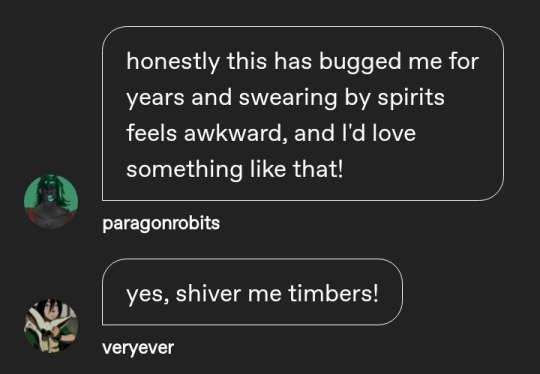
@paragonrobits @veryever alright, here we go. Technically-not-swears to give your writing a punch that "oh spirits" does not.

@terulakimban, @mikaslilworld, and @589ish were asking for this too so I'll mention them so that they're sure to see it.
Adjectives:
Misbegotten. Implying that someone is of questionable parentage is generally seen as in poor taste at best or incredibly insulting, vulgar "fighting words" at worst.
Cursed. Implying something or someone has done something deserving of a curse and have all the bad luck and unpleasantness that comes with it. Probably the most mild example here.
Damned. Considered more severe and material than "cursed" and often refers to a spiritual sentence or a fated misfortune. Whether or not this is an actual swear can depend on the person and the circumstance.
Poxy. This one is a little spicy because while on the surface it's just referring to illnesses like smallpox, cow pox, or chicken pox, historically, it referred to what English speakers euphemistically referred to as "the French pox" aka syphilis.
Nouns:
Animals. Referring to someone as an animal, especially one associated with unsavory personality traits (snakes and rats come to mind as a prime example), is often considered insulting and even dehumanizing. Note that asses and jackasses are actual animals and how off-limits those words are entirely depends on context
Witch. Often used in place of "bitch" becsuse it rhymes and can be used just as insultingly.
Scum. Refers to just about any icky substance that won't go away
Son of a ____. Insulting one's parentage is again in poor taste or straight up fighting words. The blank can be filled by anything: animals, unpleasant or unwanted things, people of any profession considered disgusting or demeaning. Have fun with it.
Inupiat words:
Honestly, if a fantasy version of Inupiat live in this world (and given two characters from this fantasy culture are named after Inupiat villages in Alaska, specifically, I'm going to specify Inupiat and will appreciate it if folks don't generalize it as Inuit) it only makes sense for Inupiat words to be used in other parts of the world. Influence and cultural exchange doesn't have to be a one way street where the "more advanced" only affect the "less advanced" and indigenous languages have always left traces behind.
Inupiat culture, and therefore language, is very matter of fact. Euphemisms aren't really used because no topic is really considered "too dirty" to talk about with any particular group. Insults are a way of showing love and familiarity. Offense is mainly conveyed through tone and context.
The phrase "anak niģiiñ" (anak meaning "poop," niģi meaning "eat," and -iñ being a suffix which in this case makes a verb a command aimed at one person) has been suggested as an Inupiat translation for the English phrase "eat shit." The words themselves are not bad words as you may think of them; the insult comes instead from how they're used to express anger at and disdain toward the person. Lots of words can be used this way, including any of the words for hell or for things I've alluded to on this post already.
If you're worried about this coming off as appropriative or insensitive, you may be lacking some cultural context for this to feel at home. Feel free to read through my "eskimo on main" tag for inspo on that. I'm willing to answer any other questions you may have as well, though be warned, I'm not exactly the quickest at responding.
Getting Creative - Basic Mode - Curses and Oaths:
We call bad words curses because at one point, they were exactly that. You were cursing someone and that was the greatest offense of it. Common curses include wishing death, illness, or injury on someone, sometimes milder but still unpleasant or uncomfortable experiences to befall them, and more rarely things like natural disasters. In a fantasy universe with fantastical abilities and animals, there are plenty of opportunities to customize this format into something exclusive to the Avatar verse.
An oath, in this sense, is a literal swear. English speakers may be familiar with "I swear on my mother's grave" or the more serious "for the love of god" being said when one is confronted. Here the offense comes from something sacred being invoked so flippantly. I think this is what people are trying to go for with "oh spirits" but it falls short for a few reasons. It doesn't invoke any one thing specifically. Anything can be a spirit and a spirit can take the form of anything. Are you invoking spirits of gentle breezes or torrential downpours? Of tadpoles or lions? Saying something like "by Koh's stolen faces!" or "lightning strike me down!" will make more of an impact than "Oh spirits" ever will.
Getting Creative - Advanced Mode - In-Universe Reference as Self-Censoring:
This one can be a little difficult to figure out, but it's probably my favorite one. Basically, you come up with, say, a historical incident or a bit of media that the people in-universe would know about because of its vulgarity. You don't have to explain it, because the whole point is that the audience doesn't know, just the characters. And you have the character's reference it to suggest vulgarity without having to spell any of it out. Allow me to provide an example:
"And then, well, let's just say I recited the last verse of The Earth Kingdom's Ode to the Firelord, almost word for word."
"The Kyoshi version?"
"The Omashu version!"
"And you got away with it?!?!"
Like most of them, this relies on the other character's reaction to sell it. It's loads of fun once you get it figured out because it feels like you got away with a lot when it's functionally just gibberish.
112 notes
·
View notes
Text
Kobayashi’s Maid Dragon S2 Episode 10 Notes

I’m extremely not an expert in birds, but I tried to look these up to see if they were a species native to New York (since they’re similar to the sparrows we usually see around Kobayashi’s place). Apparently there are few similar-looking species in New York? My totally uninformed guess is that they may be house sparrows.

The sun sets in Japan relatively early (probably around 6:30pm when this episode takes place), which would make it entirely plausible that if she just flew east (with a slight northward angle) she’d find herself over New York in the early morning while most of the rest of the country is still dark.
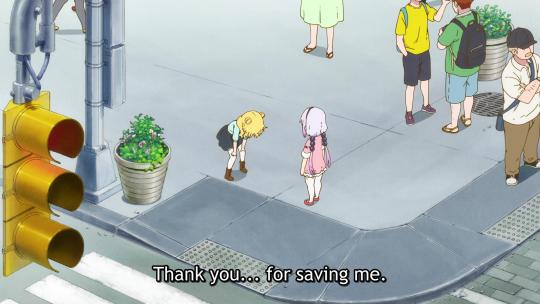
These bumpy grey pads at the pedestrian part of the intersection here are known as (among other things) tactile paving; they’re to assist people who can’t fully rely on eyesight to get around.
Interestingly (imo), they were actually invented in Japan in the 60s (by a Miyake Seiichi), where today they’re extremely ubiquitous. They even show up later this episode!

They’re often referred to in Japan as 点字ブロック, tenji (Braille) blocks, and they tend to come in two types: the “dot” design, which indicates a place to stop (or an angle change, or more generally “caution”), and the “line” design which indicates you can safely keep going. They’re generally colored yellow in Japan, ideally making them stand out more to help people with impaired vision find them, and are mandated by law in most places public transport can be found (among others).



Not really a translation note, but “deer cola” felt especially funny in the context of all the horse medicine stuff.
I guess “[animal] [drink]” is a common branding device in-universe, given the crab beer Kobayashi’s always drinking.
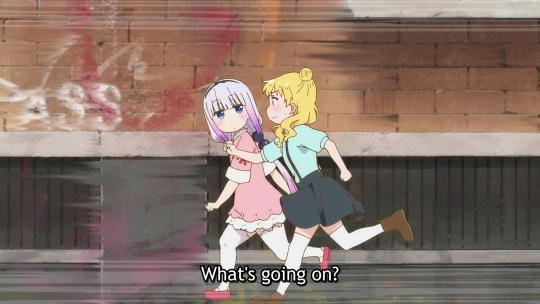
Also not really a translation note, but the difference between how “hard” Kanna and Chloe are running to be at the same speed was a nice animation touch.

遊んだ遊んだ! asonda asonda!
One feature of the Japanese language is a very heavy use of repetition. This includes “reduplication,” a linguistic term for creating words by repeating a root (e.g. a “boo-boo” in English or the dara-dara example below in Japanese), but also just like… saying the same word multiple times, as Chloe does here.
Typically this is done for emphasis or to help increase clarity: if you’ve worked in a Japanese office, you’ve likely heard someone in a phone conversation say desu desu in response to someone asking for confirmation.
This acceptance of repetition sort of extends beyond the obvious uses like this as well: for example, personal pronouns are much less common; instead (if the subject isn’t dropped) you’ll often just use the person’s name again. You’ll notice similar trends with other types of words as well.
Not to mention the ubiquity of things like otsukare.
This often ends up being a challenge for translators, because reusing words in English (when it’s not for an obvious reason) tends to stick out rather unflatteringly, even if they aren’t that close together.
(Like when I overuse “hence” in these notes.)

This “Christ��� in the Japanese was “ったく” (short for 全く mattaku, but just used as a semi-generic exclamation). I mostly bring this up because it’s a good example of a word that doesn’t work out of its cultural context; e.g. it wouldn’t make any sense for a fantasy character to say “Christ,” but since this is an American speaker it works just fine (and helps distinguish that fact, even).
I think I’ve mentioned this before, but English uses a lot of “explicit reference” words like this, that can break immersion if put in the mouths of characters who wouldn’t have exposure to said reference—which can be annoyingly limiting when trying to write dialogue sometimes.

As a bit of a culture shock for a lot of Americans I’ve met, most Japanese homes tend to have wall mounted air conditioning units, like this one, that are only for heating/cooling the one room they’re in. (Many also have a “Dry” setting that makes them act kind of like a dehumidifier as well.) It’s common to not have them in every room, like bedrooms, however.
This is in contrast to the central air conditioning system used by a majority of homes in the US (though type/use of AC in the US varies a lot by region; less common in the north for example)—and places like the UK where apparently residential AC units of any kind are quite rare.
You may have noticed that the doors between rooms always seem closed in Kobayashi’s apartment. That’s not just to make the backgrounds simpler, it’s also a good habit to keep if you’re going to be running the AC!


“Kobayashi, are you お休み today?”
“Yeah, お休み.”
お休み o-yasumi, is a noun form of the 休む yasumu, to rest. The word has a variety of applications, as we see here. A day off work/school, i.e. a rest day? お休み. Want to say “good night” to someone before bed? Also お休み.
In this case, it’s not even necessarily clear it’s being said as a pun; as mentioned earlier, repetition is a common feature of the language, so despite the yawn there wouldn’t really be any reason for Kanna to think Kobayashi was about to go to nap or anything.

“Laze about” here is だらだら dara-dara, another phenomime (擬態語 gitaigo in Japanese)—one of those words that mimics the “sound” of an idea/concept/state, which don’t actually make a sound per se.
These phrases aren’t necessarily childish or anything (overuse of them can be, but you can find them even in news articles and political speeches for example). They are, however, used frequently by children, and by adults talking to children, as they’re very “easy” words: they’re expressive, they capture useful daily-life concepts, and they usually roll off the tongue. You’ll notice, for example, that Kanna uses them a lot.
Kanna has a very interesting way of talking actually, which I’ll touch on a bit more later.


Kobayashi’s “bean jam” here is あんみつ anmitsu, a traditional Japanese dessert (technically a spinoff of mitsumame). It typically is a mix of red beans (and/or red peas), agar (an algae-based gelatin equivalent), some fruit, some variety of rice flour product (shiratama in this case, similar to mochi), and a syrup (often black sugar based).
You can find it year-round, but it has a strong summer association and is even used as a summer season word. (It’s typically chilled and you can often get it with ice cream as an ingredient.)
It’s also sometimes paired with a green-tea flavored something as well (e.g. ice cream, agar, or syrup). The trinity of green tea, red beans (aka azuki), and shiratama makes what I like to think of as the “Japanese S’mores Flavor (for Adults)”. No I will not elaborate on this.
I will though point out the shaved ice flavor Kobayashi ordered later in the episode:


え?今スイカ様子あった?
A word of note here for language learners is 様子 yousu, which has a lot of definitions, but in cases like this where it’s attached to a noun or phrase means roughly “the appearance of __” or “an indication of ___” etc. In actual use, it typically means something that makes you think of whatever ___ is—or the lack of something that would make you think ___.
For example here, it’s like “Watermelon? Where’d that come from?” (since the TV was talking about a different dessert-y food entirely).
Or an unrelated example: “I think that guy is hiding something” → “Really? I haven’t seen any yousu of that.” In other words, it can be a lot like “sign,” as in “I’ve seen no sign of ___.”

These color-bordered envelopes (originally colored based on the flag of the country of origin) used to be the standard for air mail, domestic or international, though they haven’t been required for several decades.
That said, they’re still popular for that “ooh, international mail!” feel (at least in Japan) and you can buy them at most places that sell stuff like envelopes. As here, they’re often used in media to immediately convey that a letter came from outside Japan.
Kanna (and Kobayashi) says エアメール, lit. “air mail” in English, which is used colloquially for international mail specifically, rather than “mail sent by plane.”
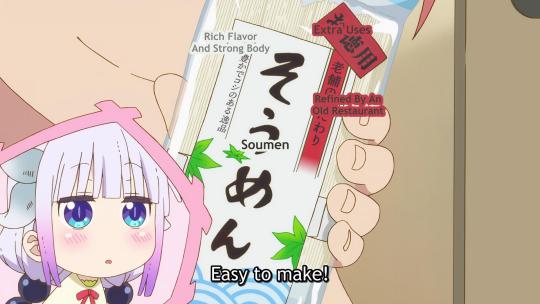
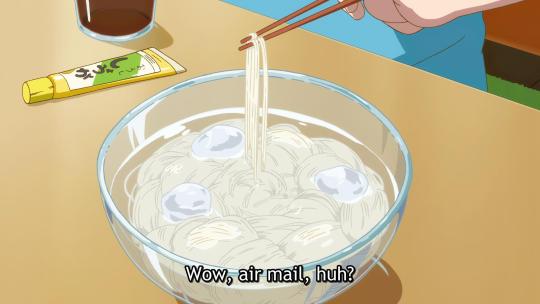
They’re having what’s called 冷やしそうめん hiyashi soumen, chilled/cold soumen for lunch here. (Soumen being a thin wheat noodle; udon but thinner.) As Kanna says, it’s very easy to make!
Basically you just boil it, wash it in cold water, add ice, get some sort of sauce to dip it in, and you’re done! It’s a popular quick meal in summer, and much easier than the more involved nagashi soumen setups you may have seen elsewhere, where they slide the noodles down a chute for you to try to grab and eat. (It’s basically the same meal aside from that though.)
(You can of course add more to it, but as we see here, you don’t really have to.)
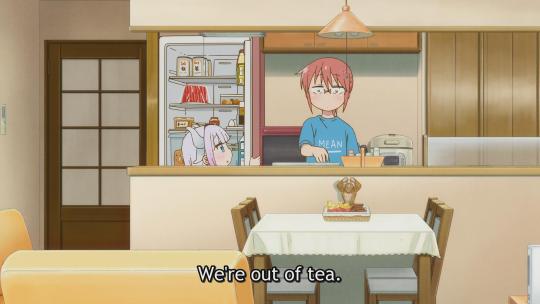
The type of tea here, for the curious, is 麦茶 mugicha, barley tea. Mugi is the general name for cereals/grains including wheat (komugi), barley (oomugi), rye (kuromugi or rye mugi), and oats (enbaku or oat mugi). It’s incredibly common in Japan (and much of East Asia), where it's the household summer drink.
It has no caffeine like many other teas, and has a bunch of various nutritional benefits, so it’s considered a good way to stay hydrated as you’re sweating buckets in the muggy Japanese summer weather.
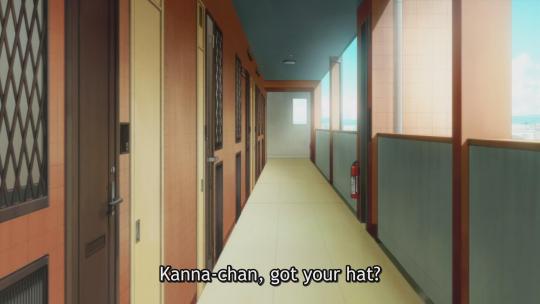

帽子した? boushi shita? した! shita!
I thought this was a cute way of phrasing this question/answer, and a good example of the “parent and their young child” way these two talk.
The suru (past tense shita) verb used here is the ultimate in “generic verb,” and it basically doesn’t get any simpler grammar-wise to phrase something as “noun+suru” like Kobayashi does here (even the particles are dropped).
Kanna, for her part, doesn’t respond with a “yes” or etc, but instead just repeats back the verb itself in confirmation.
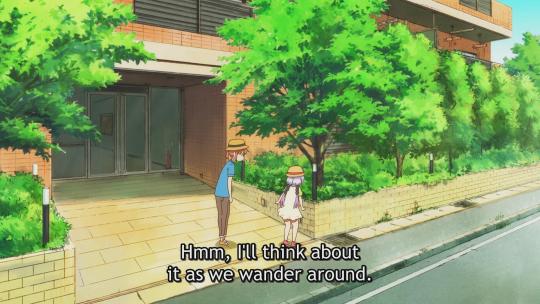

Just to note another one of those words like dara-dara: bura-bura, used for things like wandering around, doing something (or nothing) casually/aimlessly, or (with one bura) for something dangling/swinging in a more literal sense, like a spider, slack yo-yo, or wind chime.
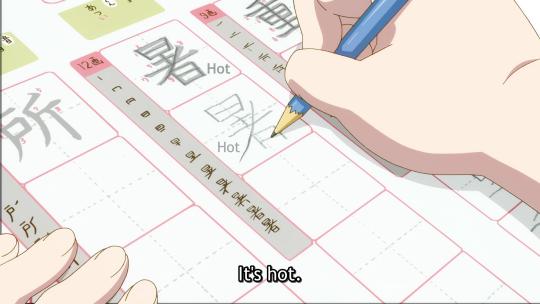
These booklets are a common homework assignment for practicing kanji; you can see along the left side there it shows the stroke order, with the first block giving an example to trace over & showing where to start each stroke.
Each character is made up of radicals (e.g. “hot” above: 日 and 耂), which each have a standard way to write them. There’s 214 such radicals (though many are pretty niche; only about ~50 of them are needed to make most characters), and once you get a hang of them it makes learning new characters much easier (not too different from learning word spellings in English imo).
Kanna is repeating out loud the reading for the “hot” character as she writes it.


In addition to the above workbooks (which usually involve both kanji and math problems at Kanna’s grade), elementary school summer homework in Japan typically involves doing an illustrated diary (not a daily one necessarily) and some sort of research project about a subject of your choice. (Think kind of like a small science fair project).
The “research” project part is pretty expansive, and you can typically even do something more arts & craftsy for it.
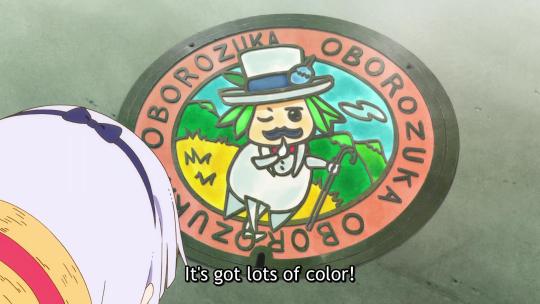
Manhole covers in a lot of Japanese municipalities feature art representative of the area. For example, the city of Chofu, where the author of GeGeGe no Kitaro lived most of his life, has several with art of that series.
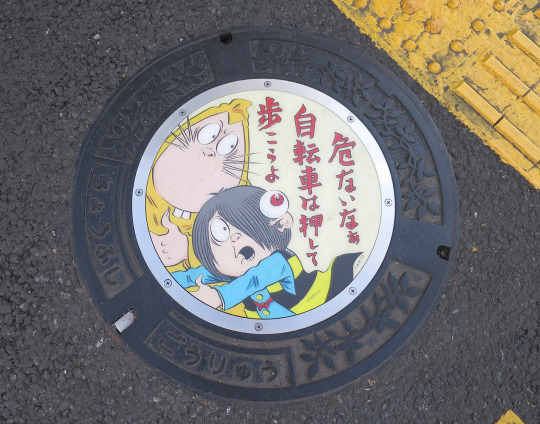
(Photo from https://www.gotokyo.org/jp/spot/1734/index.html)
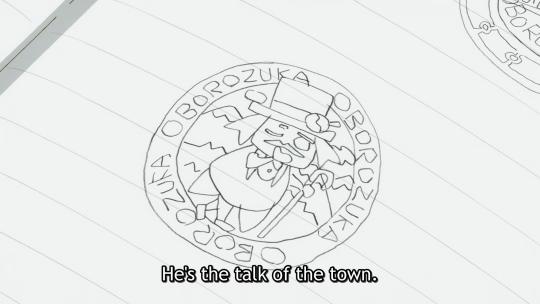
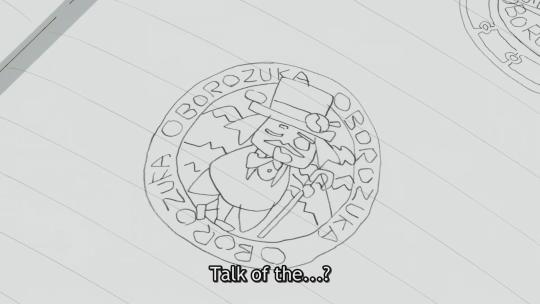
I mentioned earlier that Kanna has an interesting way of speaking. Probably a better way to put it is that she has a pretty convincingly childish way of speaking (despite the monotone). That is, she uses simple grammar and “easy” words most of the time, but then throws out random big words and fancy idioms from time to time that make you go “...where did you learn that?”
In this case, the phrase she uses is 巷で人気 chimata de ninki. Chimata originally means like a fork (in the road), and since those are often places with lots of people passing through, it expanded to mean “the undefined place where people talk about ~stuff~.” So it’s used for “many people are saying~” or “word on the street is~” types of situations (or “talk of the town,” as here).
It’s kind of an “adult” word though; for example the character for it isn’t included in the jouyou kanji (the 2000+ that are taught in elementary through high school). Hence Kobayashi’s reaction here.
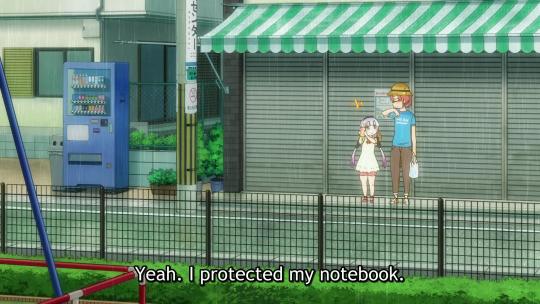
The word she uses for “protected” here is 死守 shishu. The word is the combination of the characters for “death” and “protect,” ~meaning to protect something even at risk to one’s life (to the death, as it were).
It's a word that you learn in third grade in the Japanese education system—the same grade Kanna is in!

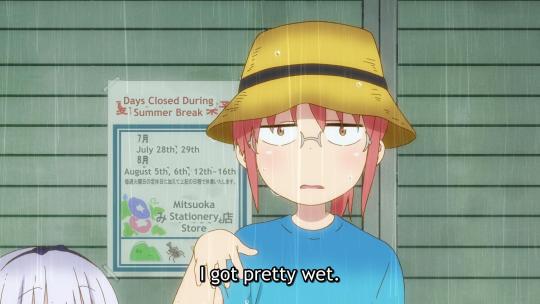
Both of these types of signs are common sights in residential areas like this: depending on where you live, it can feel like there’s always some sort of construction project going on, and Japan’s many family/individually-owned businesses like this tend to be closed on various extra days during the summer (and certain other times) to allow for time off.
In this case, them being closed August 12th~16th implies they’re taking off for Obon (and probably leaving town to visit family).
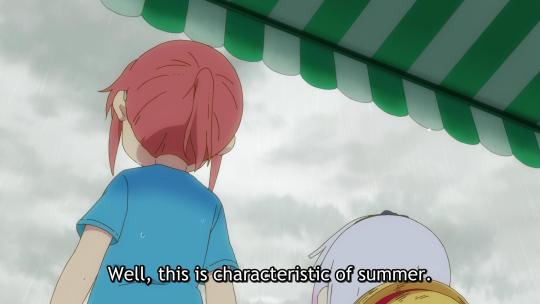
The word Kobayashi uses here is 風物詩 fuubutsu-shi. Fuubutsu refers to something that makes up part of the “scenery” of a place or season, in a pretty broad sense. This shi typically means “poem.”
So fuubutsu-shi is originally a type of poem celebrating a season or a scene of natural beauty, that sort of thing. From that, it’s also now (more popularly) used to describe things that are representative of a season; the kind of stuff you say “it’s not winter until…” about, or “you know it’s summer when…” (It can also be used for places + seasons, like the ice sculptures of Hokkaido winters, or even summer Comiket in Tokyo.)
They’re very similar to the season words I’ve mentioned previously, though they’re far less strict about what counts as one. Here, Kobayashi’s could be referring to the whole package experience of “having to take cover and wait out a sudden heavy rain, despite it being mostly clear skies a few minutes ago,” which you could call fuubutsu-shi (summed up probably as like 夏の雨宿り etc.)
In contrast the relevant season word here would probably be yuudachi (or niwaka-ame), a word referring to the short, sudden bouts of rain that tend to fall (from cumulonimbus clouds, the makings of which are noticeable in the backgrounds before this) on summer evenings.

Feels like in season one she woulda eaten it. Three cheers for character growth!
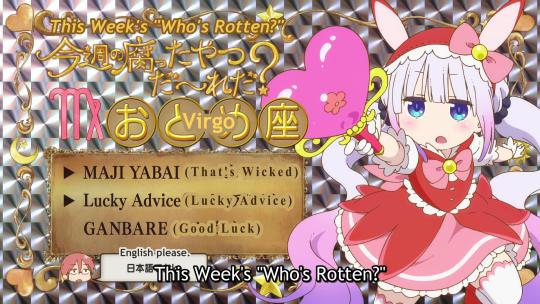
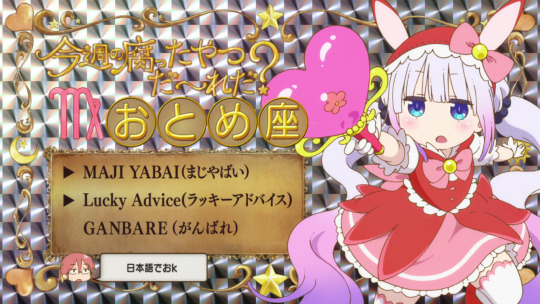
The parentheticals there are just the “English” in hiragana/katakana.
Kobayashi’s comment (nihongo de ok, roughly “you can just use Japanese”) is an internet-born term people originally would use to reply to someone who said something that didn’t make any sense, had terrible grammar, or was so full of katakana loanwords it was hard to read etc.
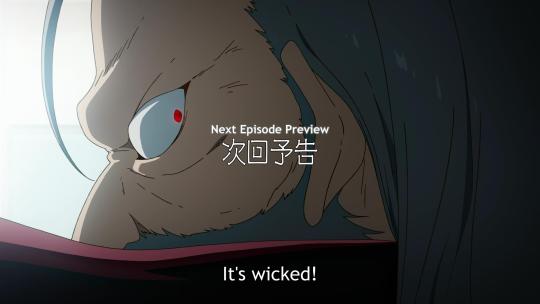
Kanna says this line in English, and while I have no proof at all, my guess is that the specific choice of “wicked” was taken from the translation of “maji yabakune?” used in season one.
13 notes
·
View notes
Text
On Komaeda’s Love Confession
The official translation for the final line of Komaeda’s free time events is as follows: “I love...the hope sleeping inside of you from the bottom of my heart.”
If you’ve been in the fandom for at least a week you’ve probably already seen the line being the most cited piece of evidence of Komaeda having a crush on Hinata. You may have also seen it being used as a counterpoint, because obv he just said he loves his hope, bruh. However, something that’s also often brought up is that this line is a mistranslation, and that in the original Japanese text, Komaeda was originally addressing Hinata as a person, but switched the direct object over to his hope at the last second. When the localization first came out this was actually a major complaint among Komahina shippers, as one can see if they look at the official video for Komaeda’s free time events on YouTube. This is backed up by fan translations of the line before the game was even released to international audiences, such as here and here.
Is this true? The fan translations are definitely more accurate than the NISA version, but does that mean they’re entirely correct in conveying the intent themselves?
My answer: ...Probably?
Now, this isn’t going to be questioning whether Komaeda is in love with Hinata outside of haha hope big sexy, because even without this line, there’s a ton of evidence to support that yes, it is more than that. I’d argue that one doesn’t even have to do the free time events to see this. What I am going to be talking about is the line itself, because let me tell you, it’s a fucking bitch.
I 100% agreed with the general consensus that this is undoubtedly an aborted love confession for about like, five years. However, one thing that has led to a little bit of doubt is that the line is rarely talked about among the Japanese fandom- in fact, just like the official translation, the “aborted” part is often skipped over when quoting it. I want to chalk it up to the change being incredibly subtle, which it is, but I’m not fully certain. Let’s break down the line itself:

Obviously, before beginning to explain this, I should clarify that unlike English, the basic sentence structure in Japanese goes Subject-Object-Verb, and nouns are usually marked with specific particles indicating their role.
In this case, the subject is Komaeda himself, and the object is something related to Hinata, referred to naturally as “you” (キミ) since he’s talking directly to him. キミの中に眠る希望 promptly translates to “the hope sleeping inside of you.”
Now, direct objects in Japanese are marked with the particle を, which are attached right after the noun. Looking at the screenshot above, you can see that it’s initially attached to just the plain “you,” but is then attached to a full on possessive phrase before he can get the verb in. Based on this, it seems like everything’s set: he was initially going to refer to Hinata, but likewise, switched it to his hope- something Komaeda has already expressed his love for in the past (though not Hinata’s specifically, just everyone in general), and in a non-romantic way too (no, komaeda was never romantically/sexually attracted to hope in SDR2. rather, he likes it in the “using religion as a coping mechanism” way. you can blame dr3 for the hopesexual interpretations).
However, that’s not the only way this line can be translated. In fact, it’s also common in Japanese for two direct objects to simply function as “and.” Komaeda isn’t exempt from this. Here’s an example:

(sorry for the youtube cutout)
“I said that I love you all who embody hope...and those wonderful talents, from the bottom of my heart.”
Again, it’s the same structure, both “you all who embody hope” and “those wonderful talents” are marked with を, and not only that, but there’s the presence of the ellipses after the former, just like in the free time event. It’s also worth mentioning that 心から愛してる (from the bottom of my heart) is used in this line as well, drawing another similarity. I don’t think these lines are meant to parallel each other at all, more like it’s just how Komaeda speaks, but it’s definitely worth noting.
If this is the way the original line was meant to be interpreted, then it would more or less be “I’m in love with you...and the hope sleeping inside of you...from the bottom of my heart.” This isn’t necessarily a new idea either. It’s how his confession in the manga (which in Japanese is the exact same line), is translated into English was well.

So, does this mean that Komaeda just loves him and his hope equally, as if the two are inherently connected? I personally don’t think so. After all, a commonly forgotten factoid is that in the very same event, Komaeda tells Hinata he never sensed a talent (ergo “hopeful”) aura from him in the first place (and he seems to be happy with this, too), so I’m rather inclined to pass it off as a generic Komaeda-ism rather than a serious mark on his character. That being said, there’s also still an “aborted” feel to it. The “hope sleeping inside of you” part sort of feels like something tacked on in order to lessen the impact of his own words, though I don’t know, I can’t say for sure. That’s just what I’m getting from Ogata’s delivery of the line, which is also open to subjective takes.
Nevertheless, this still leaves open holes. If Komaeda so blatantly said that he loved Hinata specifically, then why doesn’t this part of the line make it into his report card? It’s simply cited as ボクはキミの中に眠る希望を心から愛してると with no regard to the initial キミを, which indicates that Hinata didn’t even pick up on it in the first place (or maybe, he just doesn’t want to acknowledge it because it’d be too hard for him. still, as interesting as this view is, it’s not supported by anything in his internal monologue).
What translation appropriately conveys the meaning of the sentence structure? I can’t say for sure. Either way, it’s a really fickle line, and I don’t blame NISA for flubbing on it. I just wanted to share these thoughts to other Komahina shippers on tumblr because I find it really interesting.
Also, as a bonus: On the use of 愛してる (aishiteru)
Many people seem to have this idea that this word is like, the strongest expression of romantic love ever. And while that’s true, it’s not because it implies a “deeper” love, but because it’s extremely bold and cheesy. Most love confessions, especially in things like anime, use 好き (suki) or 大好き (daisuki) instead, and it doesn’t make them any less important or genuine. It’s just how normal people usually talk. Komaeda actually uses these two terms instead of aishiteru in his confession to Hinata in his Drama CD, just an fyi.
Also, the word isn’t necessarily romantic either. Like, when I was in Japan, my host mother just like casually said it to a friend as a goodbye as we were leaving her house. Likewise, Komaeda using it in this line isn’t what indicates that his feelings for Hinata are necessarily deeper or romantic than his “feelings” for everyone else, because if you’ve noticed before, he uses the same word to describe his love for hope, talent, and even Junko at the end of DR:AE. If anything, what it’s supposed to say about Komaeda is that he’s really embarrassing and overdramatic in expressing his emotions. It’s honestly just kind of dorky.
129 notes
·
View notes
Text
march - just some thoughts
i have read more this month than any other month? and its not slowing down its only 3/12 so i have 2/3 of a month to go and i’ve read 26 chapters. even if these chapters are ‘short’ at 10 pages, if i wanna count by ‘20 page’ chunks i’ve still read 13 chunks so far. and i’ve still got more time in the month left. most other months i’ve managed to read ‘a lot’ i read 10-20 chapters. so i’m doing really good.
grammar is a weird thing? in reading i feel like its quite easy now to understand. when listening or watching - same. and yet if asked ‘why do i say/type X’ or ‘why is it written/spoken like X’ i have absolutely no explanation in my head. i could not explain the grammar if prompted. this puts me in a weird place and i feel like i SHOULD go over a grammar guide again just so i can WORD what i’m intuitively understanding.
this is a bit bizarre to me because within the first 6 months of study i DID read through an entire grammar guide just to get an idea of what i was about to look at, and it hardly made sense once actually reading/watching/listening. i understood the guide fine, but actually Seeing chinese i was still confused. i would reference AllSetLearning’s Chinese Wiki on some basic points, then after 6 months i just stopped. now its been what 1.5 years and - reading is so easy, listening is so easy, grammar wise. none of the grammar confuses me. but i no longer ‘explicitly’ have any idea what the fuck the grammar is. i used to. i studied it explicitly before trying to read/listen. and yet now that i can read/listen, i have no idea how to explain the grammar. i can listen to a podcast and i don’t think about what the grammar is i just get it. i read and just know what i’m looking at. its like english - i cannot fucking explain it. Which makes speaking/writing a bit hard. Because when i try to check if i’m right i have no fucking clue HOW anymore - i just say/write what comes to mind and HOPE it makes sense. i have no way to conciously check for errors except ‘does this feel right’? And that’s not good enough for me lol. So I definitely do need to eventually read a grammar guide for explicit explanations again.
Technically I think “English and Chinese Grammar Side By Side” grammar book would be an excellent one to use. Because i read the first 50 pages of it and it compared it to english (so it explained english too), and it was very easy to understand and started basic then got more involved.
I’m probably gonna use my very old Chinese Grammar Self Taught by Thimm book instead. Just because I really like that book. Then I guess use another after (probably Basic Chinese Sentence Patterns since its modern and perfect for ‘catch your own mistakes’ study and much shorter than Eng+Chinese Grammar side by side).
Anyway I’m in a very weird place right now lol. I know i’m understanding grammar that is stuff I never even studied initially in the grammar guide, but unable to explain what it is, and a lot of stuff i did explicitly study in a grammar guide i completely forgot the explanation for. My reading and listening is GREAT, because all my effort only has to go into learning new words lately! its relaxing! Its the only part i need to do! But my writing/speaking i am very concerned about because being able to check myself for mistakes is something i’d like the ability to do.
how grammar is presented really makes a difference in how well i get it. there is some serious benefit to ‘show simple first then build up what you know’ that text books tend to prefer. versus like grammar reference books that may start with some in depth stuff.
i tried to read a japanese grammar guide the other day and 1 it was great but 2 it covered some ADVANCED stuff i never learned in genki 1+2, and so it was Explicit grammar description of stuff i had literally years ago been immersing in japanese and Still not conciously known about. So i felt. Overwhelmed lol. I felt so confused. I feel like I might switch to Tae Kim’s grammar guide primarily just because its structured with basics covered first. and i feel like until the basics are again glued into my brain, seeing even more advanced stuff just confused me so much i had no idea how to remember it. which is funny because? my usual strategy with grammar guides is to just read it and let what sticks stick and what is confusing be moved on from, in the hope i will later see it again and understand it better. so like based on what i usually do i should’ve just been able to read through it (and i’m gonna try anyway lol). but truly japanese grammar just... my mind does not like wrapping around it and remembering it. (chinese grammar is so much easier for me... so much easier....;-; )
i have been tempted to just Restart Nukemarine’s LLJ (Lets Learn Japanese) memrise decks, because I KNOW they worked for me last time really really well. And they include Tae Kim grammar lessons. And I know if i did it then maybe i’d get back to where i was years ago pretty fast.
I tried Earthlingo app. Its a cool idea, I don’t think its worth it though unless you planned to get Rosetta Stone (since Earthlingo is FREE). Earthlingo features 1000 words per language, taught to you by exploring video game worlds as an alien. Its a cool concept, but since all words seem to be nouns then you aren’t even learning the most common verbs/adjectives. And 1000 words is not a lot. And you could learn 1000 quite fast if using srs flashcards like Memrise or Anki (think weeks if you push yourself, and a month or two months if going at a regular pace). Earthlingo you have to slowly explore the worlds so that eats time, you have to choose to test yourself (so you don’t review nearly as often as flashcard apps), and one test includes walking around the world clicking the object which you’re given the word for (takes time to find the right object). All this means a word that might take maybe 15 minutes to study over a few weeks, might instead take much longer to study and learn. I don’t use duolingo because it generally covers so few words (usually 2000-4000 i think which is good for a beginner resource but you have to do the WHOLE course to get to all those words and i take so long on duolingo that could take YEARS for me versus a month on a flashcard app or clozemaster). Duolingo I also don’t use because it very slowly paces learning material (it takes me months/years to get through 1000 words on duolingo - just personally i go so slow on it, i think faster people would find a use for it). Likewise Lingodeer takes me AGES to get through (and i think covers 2000 words nowadays? I’m shocked Duolingo has more words for the japanese course tbh). However, Lingodeer is by far the best ‘app’ for Japanese grammar lessons in app practice form. Even if basically all the apps feel pretty slow to me in how fast they give you new info. Earthlingo is cool that its free, and for learners 12 and under i think it would be super useful as a way to engage them and keep them studying (since what child likes flashcards? whereas as a child i would’ve loved this). But as an adult Earthlingo is sooooo slow on how fast you can learn words, and it does not even offer very many words (1000 is a nice bare minimum but without verbs/adjectives it can only be a supplementary learning tool for beginners at best).
Link about Lingodeer having 2000 words in a course. (Since its SO hard to lookup how much vocabulary lingodeer includes :c )
Nukemarine’s LLJ memrise decks (which I’m considering going through again but ToT agh flashcardssssss.... they sure do work though agh)
http://www.chinese-grammar.com/beginner/ - this is the site I read a chinese grammar guide on at like Month 3. I am rereading it now maybe it will help me remember wtf grammar explicitly is. ToT (A tip, read Beginner, Intermediate, Advanced sections). Last time I visited the site you just clicked a section, then saw each fully explained grammar point and clicked ‘next’ it was nice. Now its laid out a little less ideal for me, but its still got all the same nice info! (Also honestly if you are a beginner I really DO like this grammar guide... it introduces basic info first, gradually gets more complex, and i could follow its logic knowing like 200 hanzi and 100 words ToT. its very easy to understand even if it takes a while to apply that info).
im probably gonna read hanshe more today. i’m at the point where either i know enough vocab, or the writers style has just ‘clicked’ idk. but now i just am not getting bogged down by unknown words and am just. speeding through enjoying the plot. Also rip me this novel has 155 chapters and im only on chapter 30.
watching japanese lets plays is really fun! i feel like im 3 years old cause i just see nouns i can learn pretty easy in context cause i know the game well, and hear some vaguely familiar verbs, but its fun! also it helps i know kingdom hearts 2 like by heart so. a lot of it makes me instantly cheerful and nostalgic. roxas’s voice is so cute in the japanese version.
oh i almost forgot: I found a book recently for chinese that for it’s like 10 page grammar guide summary at the beginning ALONE i think is more than worth the 4 dollars it costs to get. It has a ton of compound words and its a reference book in mandarin and cantonese (it has pronunciation for both, all characters are in traditional). I got it initally because it as a bunch of compound words and I’d like to get better at knowing a lot of common ones. But the intro to the book has a page explaining sentence structures in chinese, then examples. Its so straightforward and to the point. I love it. The book is “Understanding Chinese: A Guide to the Usage of Chinese Characters” by Rita Mei-Wah Choy. (There is also a companion book for individual hanzi, which is nice but this book specifically I’m finding more useful).
what i really like about Listening-Reading method, and reading, as study activities: no matter how I do them it is only improvement. I have a tendency to ‘redo’ material i don’t feel i fully mastered, or refuse to move on. So when i have duolingo, flashcards (sometimes i can move on if i ignore reviews/make myself do new stuff), books, grammar guides, self guided classes - i have a tendency to redo the material. over and over. and not progress and challenge myself. whereas with reading - every time i look up a word its useful because its new or something i clearly Need to review (not something i’ve actually learned and can move past reviewing). so whether i reread material or read new stuff, as long as i run into things i find somewhat challenging (feel the desire to word look up), i know i am running into new material i can learn. Same with listening-reading method: whether i finish a book or just skip to random books, any new chapter i do will give me new words to learn/remember (until i’ve reached a point of perfect listening comprehension which is a WAYS away). There’s no way for me to mess it up. I can give up a book im bored with, i don’t have to stick to one resource to the end.
someone tell me why professionally made chinese audio books almost NEVER line up to the chapters???? whyyyyy ;-;
Even More Notes lol:
So I read so much in Pleco, which auto pronounces, I have COMPLETELY forgot. 得 地 - for these two, when they’re attached after a description like 淡淡 慢慢 高兴 etc, when are they pronounced di versus de???? i’m pretty sure 得 is pronounced de when its an adjective like ‘-ly’. but for 地, i don’t remember if when part of a describer if its pronounced di or de????
#rant#march progress#march#everyone using ore in kh2 is hilarious a lil to me tho#u are all bishies u are all tiny kids WHy u acting so tough lol
12 notes
·
View notes
Note
Hi, I'm the anon who wanted to learn some basic Spanish and I'm looking for grammars
♡♡♡
So my first recommendation is for www.studyspanish.com/grammar because they have a really good intro to the basics of pretty much all of the grammar (minus some more advanced things)
Also I would recommend: https://tildesites.bowdoin.edu/~eyepes/newgr/ats/
And I can't go over every single piece of grammar in Spanish but I will do a very bare bones overview of the major tenses/moods that you'll find in Spanish and a basic explanation of them
If you're a beginner a lot of this may go over your head until you're there but I'm not totally sure of anyone's level so!
Strap in everyone, it's a long post again and I'm going to explain like a solid 65% of the most important Spanish grammar concepts including tenses and moods, and even I think I need a read more for this one.
I didn't include things like concordancia "agreement (between nouns/adjectives)" and other fundamentals because I assume you probably are aware of those and so I'm focusing more on verbs and tenses/moods, but if you are a total beginner I'm more than happy to discuss the fundamentals in more depth
As always if anyone has any questions on anything I've mentioned here specifically, please let me know. I have no problem delving deeper into specific concepts but this is just a general overview of most of the big grammar concepts you're going to come across as you learn Spanish.
-
First things first, they don't totally teach you this in Spanish, you kind of just have to figure it out yourself or delve into it later on by yourself but there are tenses and moods. I mean they teach you that there are tenses, but they don't totally explain the idea behind tenses and moods and I think it helps to know them to keep them straight.
It's not required learning but it is helpful for overall concepts. It is required learning if you're going more into the linguistics side of things though, but practically speaking you don't really need to know what a mood is to use subjunctive, but I find it helps.
-
What is a linguistic mood?
In Spanish a mood [modo or "mode"] refers to the ways in which grammar should be used. The moods encompass the tenses themselves.
There are three moods, and really you only need to worry about two.
There's the indicative, subjunctive, and the imperative.
Getting imperative out of the way real quick, it's commands. Commands are very easy to spot because they boil down to affirmative commands ["do it"] vs. negative commands ["don't do it"]. There are some things to mention with imperative but I'll do that towards the very end for miscellaneous grammar concepts
Indicative mood is hard to explain linguistically. It's honestly mostly defined as "not subjunctive or imperative". This is default explanation of things. Most of the tenses are indicative - present, preterite, imperfect, future, conditional.
Subjunctive mood is harder to explain but really important. It doesn't totally exist in English, at least not in a noticeable way so it's something that people really struggle with. Subjunctive mood is usually described as the mood you use for desires, wishes, polite requests, imposition of will, hypotheticals etc
You usually find that subjunctive is 1 of 2 things. It's usually either a kind of imposition of will, where it's one subject making a wish/request or imposition on another subject like quiero que hables "I want you to speak"....... or it's subjunctive clauses. Subjunctive clauses tend to be kinds of conditions, that something will happen once a condition is met; "until", "unless", "so that", "as long as", "provided that", "even if", "as if it were"... Those are kinds of subjunctive clauses.
Some subjunctive clauses make more sense than others for English speakers. It can be its own sort of topic.
...
A Tense on the other hand [tiempo or "time"] in Spanish refers to the time in which grammar is used.
A mood is used to explain the way in which Spanish gets used, but a tense determines if you're talking about it being past, present, or future... or something in between.
You can usually divide the tenses between past, present, or future. There are some "in-betweeners" which I'll mention in miscellaneous but in general it's like this:
Present [things happening now at this very moment] = Present Tense, Present Subjunctive
Past [things that happened or things started in the past (either completed actions or ones that may still be going on)] = Preterite, Imperfect, Imperfect Subjunctive
Future [things that will happen or have the ability to happen] = Future, Conditional, Future Subjunctive [*obsolete now mostly], Imperfect Subjunctive [sometimes] .......also ir + a + infinitivo expressions are somewhere between present tense and future, it's a thing, we'll get there
Again, tenses don't have much to do with the imperative mood because a true command is always "do it" or "don't do it" at that moment. If you're saying "I want them to do it" or "I wanted them to do it" that becomes subjunctive.
-
Present
The present tense is probably the most important tense because it encompasses a lot of things and it isn't always talked about fully. Plus it's the tense you use the most.
The present tense as the name implies talks about things happening now. Most of your declarative statements are things happening in the present. "I am", "you have", "we are here", "it is blue", etc tend to be present tense
The other facets of present tense are what make it more important than most tenses. In present tense there are two other important functions: "continuous present" and "short-term future"
Continuous present is synonymous with the gerund/progressive forms which I'll talk about more below in miscellaneous. What continuous present means is that you may be translating it as the -ing forms in your head. For example: leo may be "I read" as a present tense declarative statement like leo mucho "I read a lot"... or it could be leo "I am reading" depending on context. It's very subtle but something like leo el libro could be "I read the book" OR "I am reading the book". If you knocked on someone's door you would hear ya voy "I'm coming (right away)"
With the gerund forms, you are specifically talking about something happening right at that moment. But it is a function of present tense as well. Both are correct, mostly synonymous, and useful in their own ways but I mention it because it isn't often mentioned
There also exists a facet of present tense that is understood as "short-term future". There exists the possibility to use present tense to talk about things you plan on doing shortly or things that will happen in the very near future. This is somewhat different than ir + a + infinitive forms since those can be in any tense. It's just something to be aware of.
Preterite
Preterite tense (also called simple past) is nice and easy. It exists only in the past tense and it's for completed actions.
The hallmark of preterite is that they're actions rather than descriptions, and often involve set time phrases like ayer "yesterday", antiayer/antier "the day before yesterday", anoche "last night" or they include things like times, dates, days, or implied time frames
Think of preterite as "I did it", no muss no fuss
Imperfect
Imperfect tense is all muss and fuss
In linguistic senses, "imperfect" means "not yet completed", or "not yet past". You see it used for description rather than concrete actions and so it is very commonly used for narration and description; telling time in the past, talking about something's appearance or moods, and uninterrupted actions
In the context of preterite vs imperfect the very basic (possibly too reductionist, even) is that the imperfect tense is often used to set up a situation while preterite marks the action that interrupts the setting
In other words; dormía y sonaba el teléfono "I was sleeping and the phone was ringing" is all imperfect and it seems to imply the sleep was not interrupted. Saying dormía y sonó el teléfono is a mix of preterite and imperfect "I was sleeping and the phone rang". It stops being description and marks an "interruption" and if I read that, I would assume either "I" woke up, or we're paying special attention to the fact that the phone rang, and that it's not just casual description
Just like present tense, imperfect tense can be used as "continuous past"... saying leía could be "I read" [past] or "I was reading" [past continuous]. You could also say leí "I read" for preterite, though that's a completed action. Saying leía "I read" sounds more like description to me
You will also find that imperfect tense is used for "used to" to describe habitual things. This can be done with the verb soler [which only really exists in present tense as "to be in the habit of" or in imperfect "used to"]. Imperfect is a simpler way but it is important to note.
So for example: iba a la playa could be "I went to the beach" [description], "I was going to the beach" [continuous", OR it could be "I used to go to the beach" [habit that may or may not continue]
You often see this "used to" with certain time phrases or something qualifying it like cuando era niño/a "when I was a kid" or something like that. It's just important to note because saying something like vivía en Londres could be "I lived in London" or "I used to live in London"... If you saw it as vivía en Londres cuando era joven "I lived in London when I was young(er)" is more specifically a "used to" sort of phrase.
Future
Future tense is exactly what it sounds like
Actions that will happen in a long-term setting. Things that WILL happen, that imply more certainty.
You'll also want to note that it means "shall" as well. It's less common in English to say that, but in older texts and especially the Bible you're going to see future tense like that... no matarás is "thou shalt not kill", literally "you will not kill"... same with no robarás "thou shalt not steal"
Depending on tone, you might see no volveré translated as "I will not return / I won't return" or "I shall not return / I shan't return". Future tense has a sense of finality to it, very much like preterite does in past.
In general I would say that the future tense is unremarkable and kinder to non-native speakers, but do note that there are Spanish speakers who sometimes use future tense the way English might use present tense; serás idiota for example is a way to say "you're an idiot" rather than eres idiota (present tense)
I would say think of that particular expression as "stating the obvious" or "it's a foregone conclusion"... I only mention it because in some countries, especially Spain, you will see future tense used like that sometimes
Present Subjunctive
Present subjunctive is subjunctive mood that takes place either in the present, or the short-term future. It carries that same continuous and short-term future vibe
Again, subjunctive typically works with a set of 2 clauses [that is, two different subjects and verbs] with an imposition of will in some way... or subjunctive clauses. These just happen to be in present
So for example; quieren que (yo) hable con ella "they want me to talk to her"... has two clauses [ellos/ellas quieren and then yo hable] with a kind of imposition of will
This is common for polite requests or someone giving orders; exige que hagamos la tarea "he/she demands we do the homework"
Subjunctive clauses in present are more straightforward once you know the clauses: sea lo que sea "whatever it is / whatever it may be", or para que sepas "so that you know", or antes (de) que te vayas "before you leave"
Conditional + Imperfect Subjunctive
These two are often taught together and for good reason
The conditional tense is indicative, but it talks about something that will happen... as long as a condition has been met. It can be a little harder to nail down, but in "if/then" statements, conditional is the "then"
Conditional talks about things in the future and that can make it difficult for English speakers because we use the same conjugations for multiple things.... podía hacerlo "I could do it" is imperfect so it's past, it means I had the ability to do it... and podría hacerlo "I could do it" is future, so it talks about something you do have the ability to do, but you haven't done it yet
Though I do need to say that "should" is usually either in present tense or conditional: debo decir "I should say" or "I must say"....
But then no debería haberlo dicho "I shouldn't have said that". That kind of should is very often conditional and that can be weird for people
The main thing to know is that conditional isn't unlikely or doubtful, it just hasn't happened yet... but it COULD.
-
Imperfect subjunctive on the other hand is a very wide topic. What you need to know for this to make sense is that once upon a time in Spanish imperfect subjunctive was used for the past tense subjunctive [imperfect being "not yet complete", again]... and then you had a separate branch of subjunctive that was more future and that would have been your hypothetical situations and contrary to fact statements
Today the same tense pulls double duty so that's why it's a big topic
You'll see it for past tense subjunctive: querían que hablara con ella "they wanted me to speak with her"
But you'll also see it for more nebulous or doubtful futures. This is the kind of imperfect subjunctive that gets used with conditional tense.
In "if/then" statements, imperfect subjunctive is the "if". And that's what we mean by hypotheticals and "contrary to fact statements"
si fuera jefe/jefa "if I were the boss" is your if statement. I would call this contrary to fact. It implies "I" am not the boss
The "then" would be in conditional because you're talking about some condition being met... si fuere jefe/jefa, no lo haría "if I were the boss, I wouldn't do it"
Or, si tuviera dinero, viajaría en el extranjero "if I had the money, I would travel abroad". You can translate it as "if I were to have".
But don't hate on Spanish for doing this. English does it too. We say "if I was president" and "if I were president" and they both mean a contrary to fact future.
...Oh also I should mention that if you look up imperfect subjunctive conjugation you'll find two forms. So like you'll see hablara, hablaras, hablara, hablaran, habláramos... and you will see hablase, hablases, hablase, hablasen, hablásemos
Both conjugations are correct, but there's a lot of history involved in this that I can't totally get into without it being a big discussion.
Suffice it to say, it's historical, and Latin America tends to use the -ara and -iera forms for both. Spain makes more of a distinction, where they'll use -ara/-iera for past subjunctive, but use -ase/-iese more for the hypothetical subjunctive
So just as an example: both Spain and Latin America would say querían que lo hiciera "they wanted me to do it" because that's past subjunctive
But Latin America would say si tuviera dinero, compraría una casa "if I had money I would buy a house"...
And Spain would more often say si tuviese dinero, compraría una casa "if I had money I would buy a house"
Again, both are totally fine, but I personally don't use the -ase/-iese forms very much in my own life. I see and read them more than I use them myself, but I'm also in the United States and not Spain.
And that's your bare bones overview of the tenses and moods
-
I'll also just include some other key miscellaneous grammatical concepts real quick:
Silent Subject (sujeto tácito)
This is very basic and not talked about often, but in English we're taught that we always need to put the pronouns in our sentences. It's always "I do this" and "you do that"
And that makes sense for us because our conjugations have less variation; "do" could be anyone
But in Spanish, it's not as common to include the subject because the subject is often implies by the verb. If hablo only exists for yo, and hablamos is always nosotros/nosotras... then mentioning the pronoun seems irrelevant because it was implied
However, habla and hablan are different; habla could be "him" or "her" or "it" or even usted. And hablan could be multiple people but is it ellos or ellas or ustedes?
It becomes more common to mention the subject if there's a chance you'll be misunderstood
The general rule is you mention your subject and the verb... and you continue on until your subject changes and then you mention a new subject so no one's confused
As an example; ella habla con Marco y siempre menciona sus amigos y familia, pero Marco no habla mucho sobre su vida personal "she talks to Marco and always mentions her friends and family, but Marco doesn't talk much about his personal life"
When it's obvious like yo [except in certain tenses], you rarely mention the subject. Saying something like yo hago la tarea, yo limpio la sala, yo leo el libro doesn't come across as "I do the homework, I clean the room, I read the book"...... it comes across as "I am the one who does the homework, I am the one who cleans the room, I am the one who reads the book"
When you mention the subject over and over when it's obvious it sounds either like bragging like "look at all the things I do aren't I great!", or it sounds like complaining "I'm the one who did this, I'm the one who did that, not you, it was me"
When it's obvious you tend to keep the subject out. But you can put it in when you want some emphasis! Such as yo mando aquí "I'm the one in charge here / I give the orders around here"... which is kind of like if you'd italicized or bolded the "I/I'm" there
Infinitives
Infinitives are the dictionary form of verbs, you probably know that already even if you didn't know what they were called
They're unconjugated so the show up ending in their -ar, -ir, or -er forms... hablar, vivir, comer for example
By themselves you read them like... hablar "to speak/talk"; that's what I mean by dictionary forms
When you come across multiple verbs together, one is conjugated and the other tends to be in either infinitive (or gerund but that's next)
So, quiero aprender "I want to learn", quiero nadar "I want to swim", or quiero aprender a nadar "I want to learn to swim" for example
Also be aware that infinitives can be used as the noun forms of verbs. That is, they are "the action or result of a verb". In English we tend to translate them as the progressive forms, but in Spanish the gerund is a verb conjugation implying motion or continuation
For example: errar es humano, perdonar es divino "to err is human, to forgive divine".
Or hablar es fácil pero escuchar me cuesta "speaking is easy but listening is difficult for me"
Gerund/Progressive
The gerund form (also called progressive) is the equivalent of the -ing forms in English
In Spanish they usually end in -ando, -iendo, sometimes -yendo, and there are a few weird ones here and there because of irregular verbs
They're different somewhat in that in Spanish, gerund is a form of motion or movement in some way, so we don't use them quite the same way that Spanish does - see above with infinitive
You're using this when you're specifically talking about something in the moment.
Very often you're going to see gerund forms either by themselves, or you'll see them with the verbs estar, ir, andar, seguir, continuar or some kind of verb of motion or continuation
As an example teniendo esto en cuenta "keeping that in mind"
Or... estoy aprendiendo "I am learning", voy aprendiendo "I'm learning" [as in "it's a process and I'm in the middle of it" or "I keep on learning and I am making progress"], or sigo aprendiendo "I'm still learning".
Additionally you can see infinitive and gerund used together in some cases: quiero seguir aprendiendo a nadar "I want to keep learning to swim"
Past Participles
The past participles are other conjugations of verbs
While the infinitive is the noun form of a verb, a participle is the adjectival form of a verb
These mostly end in either -ado or -ido... although there's a whole host of irregular ones that you need to memorize
By themselves they can be just straight up adjectives and can lead into the passive voice... or just used by themselves
dicho eso "that said / that being said" where dicho is the past participle of decir
Or something like limpiado "cleaned" is the past participle form of limpiar "to clean"; and you could say el suelo limpiado "the cleaned floor" or la ventana limpiada "the cleaned window"
Past participles lead straight into passive voice, or the perfect tenses
Perfect Tenses
Speaking of the perfect tenses, these are "tenses" that are sort of their own thing but they use forms of the verb haber + past participles
The perfect tense is like a time traveler. It can exist in any tense and any mood (minus imperative). It's function is to make everything just a little more past tense
Again, if "imperfect" means "not yet completed"... then "perfect" means "already completed", since it literally means "done thoroughly"
The perfect tenses make use of haber and you most frequently are going to see present perfect and the pluperfect [sometimes called pluscuamperfecto which is "more than perfect"... aka "past-er than past"]
These follow very closely with English.
he hablado is "I have spoken/talked" (present perfect), and había hablado is "I had spoken/talked" (pluperfect)
The goal of perfect tenses is to make everything a little bit past tense while still keeping the impact of it in the present which is why I say it's a time traveler.
Instead of hablé "I spoke" you're saying he hablado "I have spoken", which means that you're now reporting on what happened once you did it. Maybe you're saying "I've talked with them and this is how it happened" or "I've already talked to them and it made no difference". Either way you're reporting on a past event but it still has bearing on the present.
Pluperfect is the same just more past. You're using the imperfect form of haber + past participle and it's very common in 3rd person narration. This is something that someone "had done". It's still got some bearing on the present but the action took place further in the past
había hablado con él antes "I had spoken with him before" makes it sound like you're reaching further into the past, but you're still going to report on how it went
But like I said, they could be used in any tense or mood except imperative; si lo hubiera/hubiese sabido, no lo habría hecho "if I had known, I wouldn't have done it"
Indirect Commands
Indirect commands are the murky space between the subjunctive and imperative moods
It's very simple though. It's basically you're telling someone else to have something be done. Kind of like delegating a command.
que canten for example is "let them sing", but it could be translated as "sing" as a plural command... it's sort of like pointing to someone and being like "I want them to sing" or "go tell them to sing"
Indirect commands are more polite than regular commands. A command can be rather brusque and impolite, depending on how it's said or phrased. Indirect commands are just nicer.
Instead of hazlo "do it" you might soften it with que lo hagas "go ahead and do it"
Indirect commands can be more impersonal and distant however. They can be used as a more... patronizing tone almost? For example: que así sea is "so be it". Literally that's "let it be so"
"We" Commands
The "we" commands are technically imperative mood but I mention them separately because they show up a lot as "let's"
For example hablemos con ella "let's talk to her"
Or something like seamos amables "let's be nice"; no seamos crueles "let's not be cruel"
It's a less common type of command, where you're part of the nosotros group, but also issuing a command to everyone else in the nosotros group
Sometimes the "we" commands are done just with present tense, but there's always the option: nos vamos could be "we're going" but may be "let's go"... while vámonos is "let's go" specifically
Oh did I mention you can stick object pronouns and reflexives onto these? Because you definitely can; hagámoslo "let's do it" or hagámonoslo "let's do it (for ourselves)"
The next ones are bigger and more confusing so I'm just going to attach my tags and other things that might help if that's okay because they are important but they're big and confusing:
Active Voice vs. Passive Voice
Indirect Objects
Direct Objects
Reflexives / Pronomials Additional reflexive stuff Dativo ético which is very advanced and confusing but involves reflexives so I will include it but just be aware it's like advanced advanced stuff
This is also not including spelling changes for stem-changing verbs and verbs with certain endings like -car, -gar, -zar.
And I also didn't mention irregular verbs just in general so they're really that's more of a linguistic thing. I can just tell you some verbs are irregular and require memorization so you get the spelling right and so you sound smart
I also didn't include por and para because good lord that is a huge topic and very confusing for people so really just better for me to link to more info on it rather than try to explain it because it's hard to do briefly in a way that feels complete and makes sense
Also I didn't include different verbal expressions like tener expressions. Those are important but sort of separate grammar concepts in my mind. If you've studied other Romance Languages you probably have seen them and are familiar, but it's more of a translation thing because English speakers are more likely to say "I am hungry" rather than "I have hunger" for example.
97 notes
·
View notes